WEYERHAEUSER IS INDUSTRIAL STRENGTH.
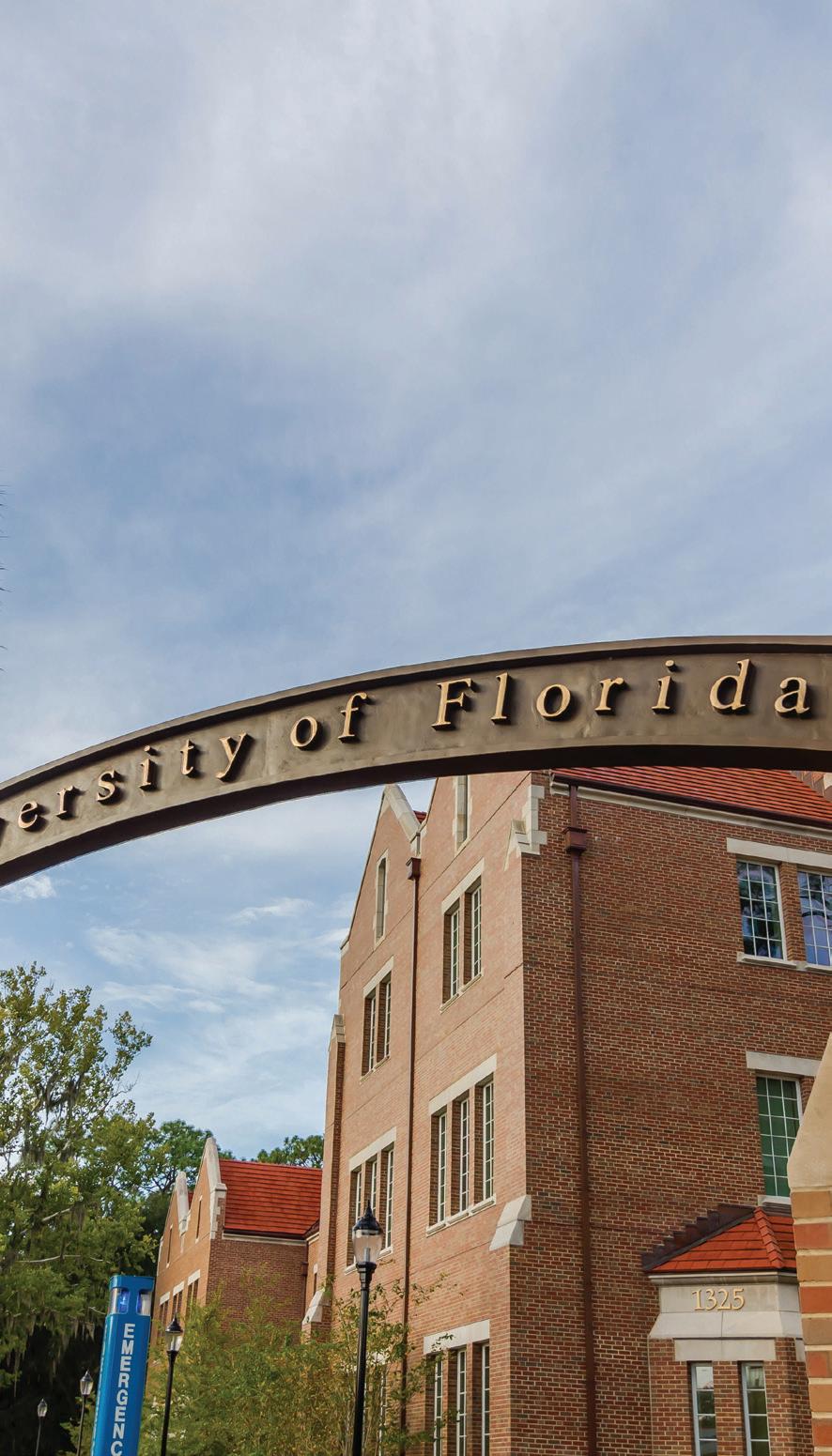




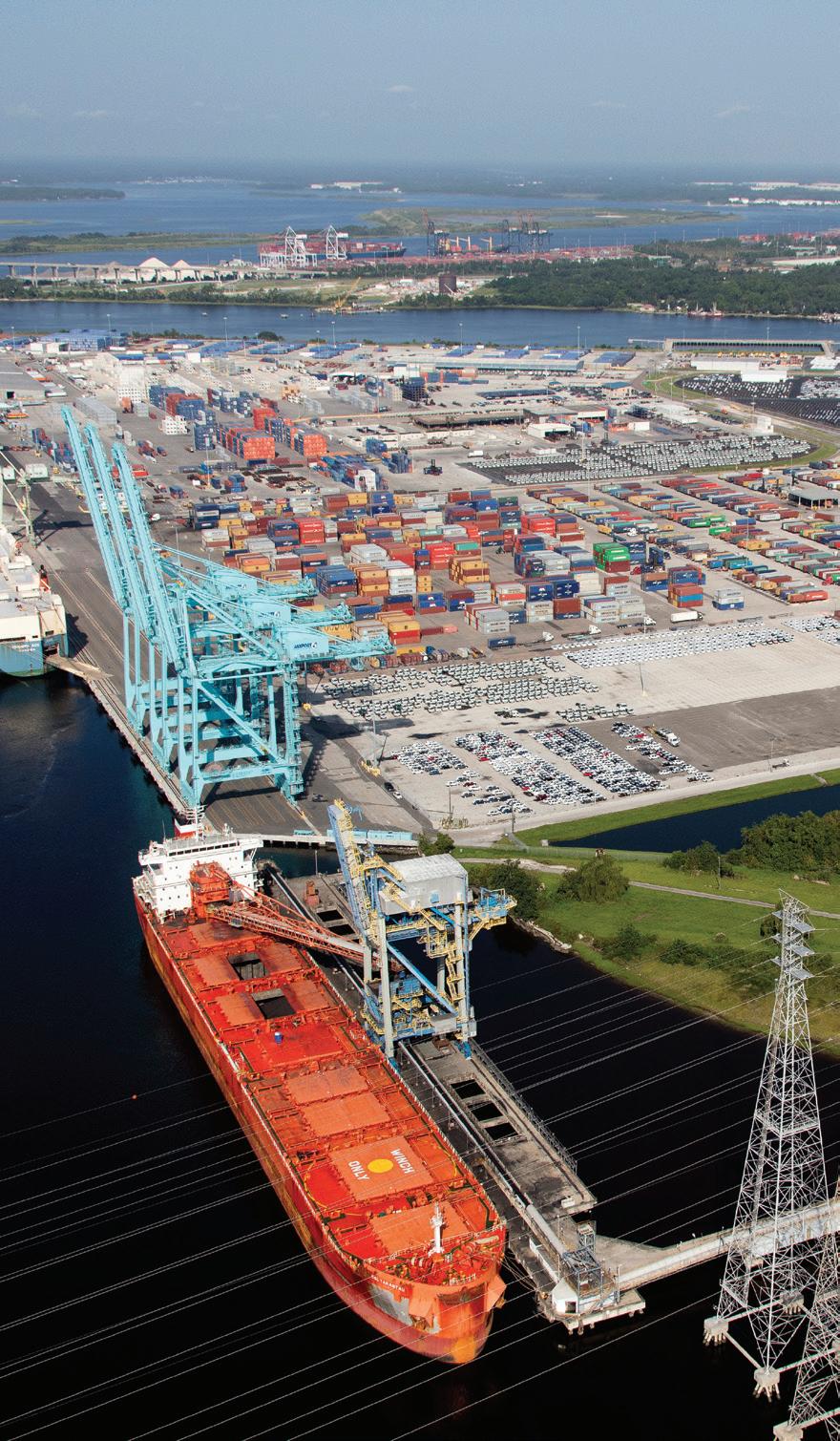
Three Outstanding Sites. One Incomparable Development Partner.
PREFERRED LOCATIONS
Two Florida Approved U.S. Opportunity Zones; Major roadway frontage (U.S. 301 - Hawthorne, U.S. 90 - NFMIP, I-16 - HGMS) and close proximity to interstate systems; NFMIP in Foreign Trade Zone #64 with JAXPORT
ACCESSIBLE TO RAIL
Convenient rail service, with rail spur directly into NFMIP, CSX borders Hawthorne and Georgia Central Railway for HGMS; significant railservice partners, including CSX, Florida Gulf & Atlantic and Norfolk Southern, with main freight lines connecting cities, ports and airports
READY TO WORK
Labor force of well over one million within 60 miles of Hawthorne and NFMIP and served by CareerSource Florida partners; over 450,000 labor force within 60 miles of HGMS with nation’s #1 state workforce training program
SUPER-SIZED AND SHOVEL-READY
Zoned acreage with utilities, approved for millions of square feet (3.5M for Hawthorne, 8M for NFMIP and 17M for HGMS) with parcelsize flexibility; designations include REDI Community (Hawthorne), RAO and CSX Select Site (NFMIP) and Georgia Ready for Accelerated Development (HGMS)
PROXIMITY TO RESEARCH, INNOVATION AND TECHNOLOGY

Hawthorne and NFMIP are close to University of Florida (#5 Public University by U.S. News & World Report) and Santa Fe College (#1 Two-Year College in U.S. by The Aspen Institute); NFMIP also adjacent to Florida Gateway College; HGMS boasts three hometown college campuses, along with Mercer University within 60 miles
hawthorneindustrypark.com
Learn more about all of our industrial opportunities, including Louisiana, North Carolina and South Carolina, at weyerhaeuser.com/land/development-projects
ESG
Deploying Location Strategy + Incentives to Meet ESG Goals
CFOs and business leaders can utilize location strategy as part of their ESG mission through their workforce, workplace, and sustainability strategies, as well as by demonstrating social responsibility and good governance.
18 The Form and Substance of Business Incentives

Government at all levels continues to provide numerous incentives to companies in varied industrial sectors in order to generate jobs and economic prosperity.
Industrial Update: shoot the Equilibrium?

Although the economic need for shorter shipping times will spur companies space around the country.
48 Strategies to Overcome Intensifying Industrial Real Estate Challenges
Companies facing constraints in the industrial real estate market should build extra time into their site searches and widen their geographic areas of search.
51 The Decentralization of U.S. Fintech Hubs
As the fintech sector continues to evolve, it’s primed to serve as a major economic catalyst in already established core, secondary, and emerging markets as well as new locations that offer the fundamentals for its growth.

of insights for assessing a possible location.

84 The Top Investment Location Prospects for Aerospace Manufacturing
Which are the most promising states and countries for aerospace production in a rapidly evolving sector-wide landscape?

Ohio Moves Business Forward
Nearly
27,000 New Jobs Last Year
$31 Billion in Capital Investment Last Year
You can count on JobsOhio to propel your next venture — from securing incentives in our state’s pro-business climate to acquiring talent from an innovative workforce. Plus, the team at SiteOhio holds an extensive portfolio of buildings and locations primed for the economic growth of trailblazers like you. Intel, Honda, and Ford are just three of the companies that chose to invest in Ohio last year. Are you ready to join them?
Expand your business in the right direction.

We must adjust to changing times and still hold to unchanging principles.
“ ”
Jimmy Carter (1924– ), 39th president of the United States, who served from 1977 to 1981 6
8
34 Fleet Electrification: Another Big Disrupter
There’s a lot to consider when a company decides to electrify its fleet, including available charging infrastructure and employee training, but the move can reduce costs and help to satisfy ESG goals.

42 Expanding the EV Battery Pipeline
44 Top-Four Location Considerations for EV Battery Plants
Prioritizing needs, identifying unique site constraints, and getting the right people involved from the get-go will ensure the long-term success of your operation.
annual report
14
87
88
54 74
exclusive online content
Companies looking to grow are facing an historically tight labor market and rising costs, but their plans to invest may be buoyed by recent government legislation.
19THANNUAL
ANNUAL CONSULTANTS SURVEY 34
Consultants responding to our survey say economic conditions are affecting their clients’ expansion/investment plans, with labor and energy availability and costs of prime concern.
• Location Factors for a Large Natural Gas User
• Old Tricks, New Methods: Streamlining the FTZ Process with Software
• How Are Economic Developers Partnering to Solve Workforce Challenges?
• What in the World? FDI Trends to Watch in 2023



“With a dedicated workforce, beautiful outdoors and low cost of living, Arkansas is hard to beat.”
Annemarie Dillard Jazic, Vice President Dillard’s
Cautious Optimism for 2023
Rising inflation, supply chain vulnerability, and labor shortages made 2022 a challenging year for manufacturers.
According to software solutions firm Aptean,1 these are the top concerns of manufacturing companies. Those responding to Area Development’s 37th Annual Corporate Survey, the results of which are in this issue, would agree.
Nearly half of the Corporate Survey respondents say economic pressures, i.e., inflation, threat of recession, etc., are their top concern. However, half also say recent government legislation — e.g., CHIPS Act, Inflation Reduction Act — would greatly or moderately affect their investment plans. And of those responding to our Consultants Survey, half also say economic pressures are their clients’ top concern, with three quarters saying recent government legislation will affect their clients’ expansion/investment plans.
While the $50 billion CHIPS and Science Act was formulated to encourage domestic investment in the semiconductor industry, “the legislation may serve as a gateway to increase investment and encourage more domestic production in adjacent industries,” say consultants at Deloitte who have the “last word” in our Q1 issue.
For the first time, our Corporate and Consultants surveys also asked the respondents to rate the importance of DEI and ESG initiatives, with between 40 and 50 percent of each group confirming the importance of these initiatives among the site selection factors. In this issue’s cover story, David Hickey of Hickey & Associates, explains how business leaders can utilize location strategy as part of their ESG mission.
Nearly two thirds of the respondents to our Consultants Survey claim they work with automotive/battery manufacturers on their location and investment projects. We continue our look at the evolving EV/battery sector in a special section in this issue. Fleet electrification is the latest disrupter, which is also helping organizations meet their ESG goals — from last-mile deliverers to utility companies to school districts.
As we move toward the end of 2023’s first quarter, views on the economic outlook continue to diverge. A February measure of CEO confidence by the Conference Board2 indicates that although 93 percent of CEOs are preparing for a recession, they feel it will be brief and shallow. It’s hoped that lessons learned during the pandemic about controlling costs, addressing supply chain woes, and embracing innovation will help business leaders to weather whatever lies ahead.
Editor
1 https://lp.aptean.com/2023_Manufacturing_Forecast_Report_en-us.html?utm_source=harmelin&utm_medium=newsletter&utm_ campaign=IMERP-NA-DA-2023-02-24-HRM12-IndustryWeek_eNewsletter&utm_content=static 2 https://www.conference-board.org/topics/CEO-Confidence
AREA DEVELOPMENT
Publisher Dennis J. Shea dshea@areadevelopment.com
Sydney Russell, Publisher 1965-1986
Business/Finance Assistant Barbara Olsen (ext. 225) olsen@areadevelopment.com finance@areadevelopment.com
Advertising/National Accounts advertising@areadevelopment.com
www.areadevelopment.com
2023 Editorial Advisory Board
Josh Bays Senior Partner site selection group
Marc Beauchamp Managing Director hickey canada
Brian Corde Managing Partner atlas insight
Kate Crowley Principal baker tilly capital
Dennis Cuneo Director Site Selection Services walbridge
Courtney Dunbar Site Selection & Economic Development Leader burns & mcdonnell
Brian Gallagher Vice President Corporate Development graycor
Amy Gerber Executive Managing Director Business Incentives Practice cushman & wakefield
Stephen Gray President & CEO gray
David Hickey Managing Director hickey & associates
Scott Kupperman Founder kupperman location solutions
Bradley Migdal Executive Managing Director Business Incentives Practice cushman & wakefield
Matthew R. Powers Managing Director Brokerage jll
Alan Reeves Senior Managing Director Global Strategy Consulting newmark
Chris Schwinden Senior Vice President site selection group
Alexandra Segers General Manager tochi advisors llc
Eric Stavriotis Vice Chairman cbre
Steven Tozier US-East Region Credit & Incentives Leader ey
Editor Geraldine Gambale editor@areadevelopment.com

Staff and Contributing Editors
Lisa Bastian Mark Crawford
Dan Emerson
Art & Design Patricia Zedalis
Steve Kaelble Mark Schantz Karen Thuermer
Circulation/Subscriptions circ@areadevelopment.com
Production Manager Jessica Whitebook jessica@areadevelopment.com
Business Development Manager Matthew Shea (ext. 231) mshea@areadevelopment.com
Digital Media Manager Justin Shea (ext. 220) jshea@areadevelopment.com
Web Designer Carmela Emerson
Halcyon Business Publications, Inc. President Dennis J. Shea
Correspondence to: Area Development Magazine 30 Jericho Executive Plaza Suite 400 W Jericho, NY 11753 Phone: 516.338.0900
Toll Free: 800.735.2732 Fax: 516.338.0100
Chris Volney Senior Director Americas Consulting/Labor Analytics cbre
Dan White Director Government Consulting & Fiscal Policy Research moody’s analytics
Scott J. Ziance Partner vorys
strong
The Magnolia State has been a key player in the automobile manufacturing industry since Nissan established its 3.5 millionsquare-foot assembly plant in Canton in 2003. Since then, Toyota and PACCAR also have established plants in Mississippi. Additionally, Mississippi is home to three of the nation’s largest tire makers, Continental, Yokohama Tire and Cooper Tire.
SEE WHERE MIGHTY MISSISSIPPI CAN TAKE YOU. Visit MISSISSIPPI.ORG/automotive to learn more.

CEOs Are Underprepared for Cyber Threats
New regulations to expand cybersecurity expertise and reporting requirements can only help to eliminate the very real threats companies are facing on a daily basis.
BY FREDERICK JOHNSON, MS, CISA, C|CISO, Vice President, Cybersecurity & Digital Forensics, MARCUM TECHNOLOGY
What do IT systems and water have in common?
Do you know the connection? You will find the answer at the end of this article.
According to the most recent Marcum-Hofstra CEO Survey published in December,1 less than one third (31.8 percent) of CEOs said their company is well-prepared for any cybersecurity threat they might face in the foreseeable future.
That’s a staggering and
sobering message. If you look at how other risks are managed, such as supply chain, market conditions, or higher financial interest rates, there is a much greater degree of focus and success.
It’s difficult to imagine that most CEOs are unaware of cyber threats. You can’t go a day without seeing an article about the latest sensational cybersecurity inci-
threats continue to be treated differently than all other types of organizational risks despite clear evidence that cyber losses can include millions of dollars, penalties, and fines; class-action lawsuits; reputational damage; and lost opportunities. Don’t forget employee attrition — who wants to work for the latest firm to become a media headliner for all the wrong reasons?
A Business Survival Imperative
Even within many large organizations, cybersecurity departments still report into IT, as if security were an IT function (spoiler alert: it’s not an IT problem; it’s a business survival imperative). Cybersecurity needs an

YOU CAN’T GO A DAY WITHOUT SEEING
AN ARTICLE ABOUT THE LATEST SENSATIONAL CYBERSECURITY INCIDENT.
dent. And none of these attacks are limited to a particular size or type of company. Attacks are impactful and pervasive.
Risks due to cyber
equal place in the Csuite. Accept the reality that IT and security have very different focuses, agendas, and KPIs. Recognize the differences, celebrate them, and place security equal to the IT function.
CEOs don’t entirely own this problem. There are many boards of directors with no significant cybersecurity expertise. Where are the board members who were former CISOs and lived through a major security breach? They are the leaders who really know how painful and expensive it is to survive
one, and they have the lessons learned under their belts.
In 2022 the Securities & Exchange Commission proposed new regulations that would greatly expand the cybersecurity expertise and reporting required of public company boards. If approved, there will be a scramble for talent with experience focusing on operating risks, strategic and practical elements of meeting existing and coming regulations, as well as future opportunities that a great cyber posture can provide. This is not to be feared — it will be a good opportunity for forward-acting organizations to get ahead.
Still wondering about the connection between IT systems and water? In 1908, Jersey City, N.J., became the first U.S. city to begin routine disinfection of community drinking water. Other municipalities quickly followed suit. Until then, citizens contracted water-borne illnesses regularly.
A strong cybersecurity capability is the disinfectant all organizations need now. Some day we will look back and shake our heads at the unbelievably slow progress of providing basic sanitation and protection to our IT capabilities, particularly given how dependent we are on them. Elevate your organization’s cybersecurity capability now, and we can all raise a cold glass of clean water to that future.
1https://news.hofstra.edu/2022/12/13/ mid-market-companies-not-fullyprepared-for-cyber-threats-marcumhofstra-ceo-survey
SOMETIMES, ALL YOU NEED IS A CHANGE OF SCENERY
SEQUATCHIE COUNTY, TN
DISCOVER A PLACE WHERE ADVENTURE, BEAUTY, AND PROSPERITY THRIVE. HERE, UNMATCHED SCENIC BEAUTY AND A CENTRAL LOCATION SUPPORT GLOBAL MANUFACTURERS AND GENERATIONS OF SKILLED TALENT. NOW IS THE TIME TO BE IN SEQUATCHIE COUNTY, TENNESSEE.




IN FOCUS
The Facility’s Envelope: A Multifaceted Ecosystem
For infrastructure preparedness, a big picture and narrow focus are equally important.

can lead to missing the forest for the trees.
BY MARC GRAVELY, Founder, GRAVELY P.C.Marc Gravely is the author of the best-selling book, Reframing America’s Infrastructure: A Ruins to Renaissance Playbook.

When discussing infrastructure preparedness, generalizing is necessarily fraught since specialization of purpose is the typical lynchpin issue of infrastructure adequacy. If, for instance, one’s business is computer chip manufacturing, one’s primary, and perhaps overriding concern, is maintaining the integrity of the clean rooms. However, that hyper-focus
A commonplace — and often costly — error leading to infrastructure failures can occur when the owner’s desires for cost control merge with the designer’s or builder’s generic assumption that — even for facilities dedicated to manufacturing specialty products like computer chips — a wall is a wall. That is, a wall (and a roof) serves its pur-
ity will take place inside. True, your computer chip manufacturing facility’s clean rooms absolutely must have an HVAC system that delivers a contaminant-free atmosphere. But the building envelope also must be designed and constructed so that it will not inadvertently foster environmental degradation, shortening the useful life of the HVAC system. Ignoring or giving short shrift to the building envelope as a multifaceted ecosystem — for drainage, air circulation, and energy conservation, to name just three — can result in significant deficits that present fertile ground for litigation-inducing deterioration of other structural components.
didn’t act as a reasonable person in the same circumstances would have done.
Appalling legalese notwithstanding, a trial lawyer’s dream case is one in which a lay jury can appreciate that the error causing the client’s damages is fundamental, easily understandable, and one that the jury members, themselves, likely would not have made. Hyper-focus is something that a jury can understand.
So is the significance of reducing maintenance costs, energy consumption, and environmental impact, all of which are reasons to pay proper attention to the building envelope. It simply makes good sense.
pose as long as it shields the interior from rain, wind, cold, or baking sunshine, and provides a reasonably comfortable space for conducting whatever business activ-
Using the “Reasonable Person” Standard
Law schools teach that the so-called “reasonable person” standard applies to virtually every area of human endeavor, at least insofar as performing below it might result in the imposition of damages following a lawsuit. No matter which of several potential pathways to liability — i.e., various formal causes of action and theories of recovery — is involved, a lawyer is always on the lookout for situations where a lay jury can easily determine that someone “just didn’t act right.” That is to say, they
Picture the plaintiff’s expert witness saying to the jury: “Not only would [insert your choice of envelope-enhancing measures here — say, for instance, triple-glazing the building’s windows] have prevented the moisture accumulation [or another foreseeable malady] that caused the environmental failure we’re talking about here, it also would have saved enough in energy costs to pay for itself in two or three years.”
A jury can get that. A jury will believe that taking those steps is something a reasonable person would have done. Failing to do so equals negligence. Hyper-focus negates ordinary care.
Once they believe that, the defendant is (pardon the legalese) toast.
THE BUILDING ENVELOPE MUST BE DESIGNED AND CONSTRUCTED SO THAT IT WILL NOT INADVERTENTLY FOSTER ENVIRONMENTAL DEGRADATION OF THE HVAC SYSTEM.
TAKE YOUR BUSINESS TO A BETTER PLACE — TAKE IT TO







CONNECTICUT
Successful companies pick the best location for their business, but transformative companies pick the best location for their people.
LEARN MORE AT ADVANCECT.ORG
FRONT LINE
The Growth of Indoor and Vertical Farming

In an attempt to deal with the vagaries of weather and changing climate, farmers are turning to vertical and other high-tech indoor farms.
has advanced, these indoor operations have been attracting more investment capital and becoming larger.
“There is a tremendous amount of experimentation going on,” says Kevin Kimle, Rastetter Chair of Agricultural Entrepreneurship at Iowa State University and director of the Start Something College of Agriculture and Life Sciences program. “There is hardly an ag tech area where there isn’t some sort of play on this going on.”
a differentiated product,” for example, some kind of “artisan” greens, he explains.
BY DAN EMERSONIf you want to see the possible future of farming in the U.S., there are a number of places to look.
One is Morehead, Ky., where AppHarvest has opened a 2.76-millionsquare-foot high-tech greenhouse to grow nonGMO, chemical pesticidefree fruits and vegetables closer to consumers.
AppHarvest has also broken ground on a second similarly sized, controlledenvironment ag facility nearby in Richmond, Ky.
Meanwhile, in Luzerne County Pa., Upward Farms, a Brooklyn-based indoor aquaponics company, is building a 250,000-squarefoot vertical farm facility, where crops are grown in vertically stacked layers. The county has also been chosen by Crop One for its third U.S. vertical farming operation, which will comprise 316,000 square feet.
Another massive vertical farming campus is planned by San Francisco-based
Plenty Unlimited Inc. at the Meadowville Technology Park in Chesterfield County, Va. To be built in six phases, it will encompass 200,000 square feet and
Like any nascent, entrepreneurial industry, vertical farming has had failures as people figure out what will work, says Kimle. The 2020 pandemic was a major setback for a number of smaller indoor growing operations, since restaurants and corporate kitchens were abruptly shut down, Kimle points out. For ex-
The industry is at the “venture growth stage — a lot of emerging technologies and venture-backed businesses with unique intellectual property,” says Djavid Amidi-Abraham, director of consulting for Agritecture, a Brooklyn, N.Y.-based consulting and tech firm. “We’re still in a very risky business environment. It’s similar to other technology boomand-bust cycles.”
Modern, large-scale greenhouses can work in any climate, he says. “The biggest limitation is that in certain hot and mild climates — such as South Florida — they are less efficient. While greenhouses require more square footage, the access to free energy (the sun) is a major advantage over vertical farming. Power use per unit of yield is much lower.”
is projected to eventually produce 20 million pounds of produce annually.
An Attempt to Remove the Risk
For decades, farming has been one of the most financially risky professions. Now, in response to several converging trends — consumer demand for locally grown food, an increasing population, and shrinking arable land — entrepreneurs are removing some of the risk by growing crops indoors, either in so-called vertical farms or in hightech greenhouses that enable growing in any climate. As the technology
ample, Clayton Farms, an operation owned by ISU lost 95 percent of its business “overnight,” he says.
The industry has continued to attract investment capital, “but for every success there are probably one or two startups that didn’t work. Sometimes the founders love the technology but forget that at the end of the day it’s still farming,” Kimle says. “Our existing ag production is really efficient, so you have to have something that is — from a cost perspective — in the range of what people are accustomed to paying. If you don’t, you really need
He says one of the major challenges to startups is the high capital expenditures for labor and energy. Regarding labor “there is a big push” to reduce workforce requirements through improved technology, including automation. On the market side, more widespread adoption of indoor-grown produce by large-scale buyers (retailers and wholesalers) would mean more market demand, he says.
Amidi-Abraham says indoor farming is not a one-stop solution for every farmer, business, or city. “Nor is any one solution in urban agriculture the best. The most fitting urban farming solution truly depends on the city, the culture, and the people involved.”
AS THE TECHNOLOGY HAS ADVANCED, THESE INDOOR OPERATIONS HAVE BEEN ATTRACTING MORE INVESTMENT CAPITAL AND BECOMING LARGER.Shown here is the Plenty facility in San Francisco.
POWERING NEVADA’S FUTURE.
• RELIABLE SERVICE.
• LOW RATES.
• RENEWABLE ENERGY.
• ENVIRONMENTAL PROTECTION.
• INVESTMENT IN OUR COMMUNITY.
At NV Energy, our economic development experts work strategically to facilitate business location and expansion within Nevada. The dedicated team can assist with energy pricing and renewable tariffs, site visits, and all the critical data needed to make an informed decision for business investment in Nevada. Our team will help you manage every step of the site location decision process.



Learn more at nvenergy.com/econdev
YOU CAN COUNT ON US.
FIRST PERSON
What data is most attractive to cyber thieves and why?
Morris: While motives vary by different cyber adversarial groups (e.g., cyber criminals, hacktivists, and nation-states), it’s important to discern those motivations as they highly impact where harmful, disruptive activity will focus. Unfortunately, most organizations need to deal with multiple adversaries at a time, making cybersecurity a difficult job. Cyber criminals typically look for financial gains through intellectual property, personally identifiable information (PII), or business critical data. Hacktivists usually focus on what they can do to disrupt business activities or expose internal organization information. And, nation-states are most likely to target unique intellectual property or access to critical systems
MICHAEL MORRIS MANAGING DIRECTOR IN THE CYBER AND STRATEGIC RISK PRACTICE DELOITTEThe Industrial Internet of Things (IIoT) and cloud technology are expected to further transform and optimize industrial operations of manufacturers. Can you explain the current cyber threat situation for those companies?
Morris: Many IIoT devices were built with a specific function in mind at a time when security wasn’t a high priority. As more and more devices connect to the Internet, organizations’ cyberattack surfaces have grown, and now span all of their critical business areas. As industrial, manufacturing, or other organizations look to defend against cyber threats, they need to begin inventorying and monitoring all of their connected assets, including information technology (IT), operational technology (OT), Internet of things (IoT), and industrial Internet of things (IIoT). Since cyber adversaries will take advantage of any organization’s security blind spots, organizations would be wise to build visibility across all of their tech assets.
What basic elements make up a great cyber defense plan? What extra services should be added for optimal protection?
Morris: There are several basic elements needed for a cyber defense plan. These include identifying core critical systems that have the biggest impact to business success, enabling the monitoring of those systems, and enabling automation to identify anomalous and malicious behaviors to mitigate threats as quickly as possible. Threat actors often leverage a lot of the same technology that cyber risk management programs do, so enabling and building your organization’s security capabilities to counter them as soon as they’re identified is key in protecting the business.
Which cyber services are best to be outsourced, and why?
Morris: There are many cyber services that managed service providers can provide. For example, we’ve seen an upward trend in organizations hiring managed detection and response (MDR) providers to cost-effectively address increasingly complex threat landscapes employing skilled cyber talent that’s often hard to come by in an incredibly tight job market.
Continued on page 53





KENTUCKY’S BUSINESS CLIMATE BRINGS RECORD INVESTMENTS
The state’s site development and workforce programs are among the assets attracting companies to Kentucky.
By Mark CrawfordKENTUCKY JUST CONCLUDED its best two-year period in the state’s history for announced private-sector investment and job creation, including 500-plus new-location and expansion announcements with $21.7 billion in new investment and more than 34,000 full-time jobs.

Companies are attracted to the Bluegrass State because of the pro-business climate, modern infrastructure, and diverse, highly skilled workforce. Kentucky’s state, regional, and local governments collaborate with each other and the private sector to expand the economic base in creative ways, forming strong, lasting economic partnerships.
For example, automotive has long been a key manufacturing sector in Kentucky, and now the state is emerging as an innovative leader in the production of electric vehicle (EV) batteries and other EV-related materials. Since 2020, EV-related investments in Kentucky have totaled nearly $10 billion, including the BlueOval SK and Envision AESC battery plant projects, which are both on track to start operations in 2025.
“As one of the nation’s leading manufacturing centers, BlueOval SK will have bestin-class supply chain management and increase the state’s manufacturing footprint with a $5.8 billion investment,” says Ursula Madden, director of External Affairs with BlueOval SK and BlueOval City.
Build-Ready Program
Kentucky’s success in landing mega-size business projects is in part due to its streamlined site-selection preparation process and the
Build-Ready program, which reduces construction time and costs for industrial sites with communities completing many of the site upgrades beforehand. Preparation can include environmental studies, permitting, utilities, and ground preparation, all of which accelerate a company’s construction timeline. Kentucky currently has 20 Build-Ready sites certified and ready to go. To date, six BuildReady sites have been selected by growing companies, including four in Bowling Green in South Central Kentucky.
“The Build-Ready program is a prime example of how smart product development initiatives can drive economic development and create opportunities,” says Ron Bunch, president and CEO of the Bowling Green Area Chamber of Commerce. “Its impact in South Central Kentucky has been remarkable, including new job creation, increased tax revenue, and a higher quality of life for residents.”
Kentucky Product Development Initiative
The Kentucky Product Development Initiative (KPDI) was recently established by the state to further upgrade industrial sites statewide. The program builds upon the success of the pilot PDI program, which launched in 2019 and quickly proved itself.
A PDI grant for energy infrastructure was critical in Pratt Paper’s decision to select Henderson for its $500 million facility.
“From first visit to announcement took only three months — our ability to meet their timeline was critical,” says Missy Vanderpool, executive director for Henderson Economic
Development.
Thanks to support from Gov. Andy Beshear and the state legislature, KPDI will invest $100 million to upgrade existing sites and is accepting proposals from communities across the state — reflecting the state’s commitment to expanding the competitiveness of its local communities and creating new jobs.
Workforce Pipelines
The Kentucky Skills Network provides workforce solutions such as employee recruitment, customized training, and skills development. In 2022, training was provided to 95,000 workers and 5,000 companies. Additional funding for training facilities and apprenticeship and scholarship programs is available through the Bluegrass State Skills Corporation.
Kentucky is one of only three states selected by the U.S. Chamber of Commerce Foundation to implement its Talent Pipeline Management (TPM) program. TPM’s goal is to develop a diverse talent pool that leverages education and workforce development systems. To date, TPM has launched more than 30 industry collaboratives that are “producing tangible results that are positively impacting individuals, businesses, and communities across Kentucky,” says Makinizi Hoover, strategic advocacy manager for the U.S. Chamber of Commerce.
From speed-to-market initiatives to a commitment to workforce development, Kentucky is helping companies take their business to the next level.


The Form and Substance of Business Incentives
Government at all levels continues to provide numerous incentives to companies in varied industrial sectors in order to generate jobs and economic prosperity.
By George Tobjy, Managing Director of Client Services, Maxis AdvisorsAn incentive award of up to $9 billion in federal, state, and local benefits for Micron’s $100 billion chip fab plant near Syracuse, New York, if employment and investment projections are achieved, has set the high bar for a U.S. project incentives award.
More than $1.3 billion in incentives has been approved to attract Panasonic’s EV battery facility which is projected to create 4,000 jobs in De Soto, Kansas.
North Carolina was successful in bringing Apple’s 3,000 jobs in machine learning and artificial intelligence to Research Triangle Park with the help of an incentives package estimated at $846 million.
While these mega-project announcements and the level of associated incentives awards grab national headlines and are regularly debated on their needs
and merits, each year hundreds of thousands of companies in the U.S. alone will secure some level of business incentive and tax benefit to conduct facility expansions, capital investment, and other employmentrelated activity.
Business incentives, tax credits, and exemptions are regularly provided and deemed absolutely necessary by the federal government, state and local agencies, and other authorities and entities, including ports, airports, utilities, railroads, and workforce training organizations to encourage and support business investment and economic activity in all corners of the country. Our federal system allows state and local governments, and the voters in their states, to set tax and regulatory policies, and the levels of expenditures they feel necessary in their public and social institutions, to develop a healthy and economically productive state and region. In the same vein, state and local agencies are able to determine the levels of government incentives and tax benefits they feel necessary and in the best interests of their citizens to attract and retain companies and generate investment, jobs, and economic and social health for their communities.
Credits and incentives can be defined in three separate categories:
• • Statutory tax credits and exemptions — These federal, state, and local tax benefits are “as of right” based on companies making qualifying investments or conducting required activities to claim the benefits. Regularly claimed statutory benefits include investment and jobs tax credits, research and development credits, targeted hiring and training credits, foreign-trade zone or ports activity credits, employment tax reductions, sales tax exemptions, qualified opportunity and enterprise zone benefits, and others. Other major tax benefits that companies regularly claim include capital gains and

foreign income deductions, property depreciation and business expense benefits, and employer health and pension contribution reductions. While these tax-based benefits do not require pre-approval by economic development or taxing authorities, the level of expertise and rigor required to calculate and determine eligible benefits that can be claimed on tax returns is extensive.
• • Tax credits and exemptions that require pre-approval — While many of these tax benefits fall in the same categories as those above, in many cases the ability to claim benefits on tax returns requires companies to apply for the incentives and secure approval from economic development agencies and tax authorities. Many of the largest announced incentives awards may fall into this category, including property tax abatements and exemptions, income tax credits for capital investments, tax credits and employment tax withholding rebates for job creation, and sales tax exemptions on facility construction and equipment expenditures. Benefits are secured by entering into discussions, submitting required applications, and securing approvals from state and local agency boards or local councils. In most cases, these benefits must be applied for and approved before any commitments or announcements are made by the company on their plans or intention to conduct the project in the state or city. Activities conducted such as signing a lease, purchasing or placing orders for equipment, hiring or posting announcements for new employees, internal announcements to company employees or internal communications that decisions have been made before required approvals have been received can disqualify companies for the incentives. While the qualifying criteria to secure approval of these benefits is based on statutes and regulatory guidelines, in many cases, economic development agencies have discretion on the benefits awards based on the amount required to secure the project and the long-term economic benefits.
• • Other negotiated and discretionary incentives — These benefits often come in the form of direct grants, low-cost or forgivable loans, free or discounted land, utility discounts and rider rates, permit and impact fee waivers, and a range of workforce development
programs. Discretionary incentives are most often programs that have specific legislated allocations and guidelines determining the range of eligible awards based on the project investment and new or retained jobs. In some instances, for the largest, most competitive projects, state legislatures may approve special allocations to provide an award to attract a specific company. A number of states have approved governors’ deal-closing funds, which provide wide latitude on the amount of benefits the state economic development agency can provide to secure a specific project.
Determining Incentives Overall Value
The evaluation of states and regions for projects by companies, i.e., the site selection process, requires a detailed review of a multitude of critical project require-
ments of which the amount of incentives that can be secured is only one — and often not the most important — factor. However, just as the long-term cost of labor in competing locations is critical to deciding the project location, incentives should be fully reviewed to determine their value in the overall project cost calculation and in reducing project investment and long-term tax and other liabilities.
A disciplined approach in analyzing the potential incentives in alternative locations that may be suitable for the project should be conducted before entering into discussions with state and local agencies. Knowing the value of the potential incentives, including the benefits to be realized based on the company’s tax structure or projected tax liabilities in the locations under consideration, is a critical first step. Companies should be clear in presenting their project plans, as well other potential alternative locations for the project, during initial discussions with economic development agencies so that any incentives offers are based on realistic and achievable employment and investment factors and commitments.
The process and timeframe to receive an offer of a
INCENTIVES should be fully reviewed to determine their value in the overall project cost calculation and in reducing project investment and long-term tax and other liabilities.
package of state and local incentives can differ significantly between states and regions. In some instances, companies can receive an offer letter within a couple of weeks by providing basic project specifications in writing or in meetings with the economic development agencies. In other states and cities, a formal offer of incentives will not be provided for several months until project applications are submitted and approved by economic development boards or local agencies. In either situation there can be opportunities to negotiate the award levels, terms, and conditions of incentives packages before a company commits to or announces their project location decision.
Adhering to Project Commitments and Terms
Companies should review and become comfortable with the project agreements, including all project commitments, reporting and compliance terms, incentives payment schedules and fees, default and clawback provisions, and other terms before accepting the incentives and making project commitments, as the likelihood of negotiating these terms is seriously diminished after doing so.
Finally, it can’t be overstated that establishing an internal process to track project employment and investments and accurately meet incentives reporting requirements is the most important part of the incentives process. Companies regularly achieve less than their approved incentives awards or default on their agreements and are removed from programs due to inadequate reporting and compliance procedures.
In recent years, many states and communities have increased the amount of application documentation and detail on such issues as project economic impact, community benefits, projected local labor and workforce participation, ESG and green building commitments, and competing locations prior to approving incentives awards. Similarly, there has been increased rigor and review of qualifying employment and wages, eligible capital investments, and other requirements spelled out in project agreements before compliance reports are approved and benefits paid to companies. States have seen the need to adjust such issues as percentage of time employees are required to work at project sites, or their calculations on employee spending impacts to the local community, as the level of remote workers and underutilized facilities remain stubbornly high. Understanding the level of complexity in securing approvals of both the initial incentives applications as well as the follow-on compliance reporting requirements is important in comparing competing incentives offers.
Unprecedented Financial Support
By all measures, since the start of COVID, the amount of business incentives and funding for companies that has been authorized and awarded exceeds any amount
in our country’s history. Of the $3 trillion CARES Act I and II (the Consolidated Adjustment Act) funding, approximately $1.5 trillion was allocated almost equally to large and small businesses through the Payroll Protection Program, Employee Retention Credit, direct grants, loans and loan guarantees, and tax benefits.
Significant funding for investments in transportation, education, healthcare, energy, and economic development projects has been authorized through the $1.9 trillion American Rescue Plan in 2021. While over $600 billion of the $1.2 trillion Infrastructure Investment and Jobs Act will fund highway, transit, and rail projects, the remainder of the investments will be made to support energy, environmental, water, broadband, port, aviation, and other public/private projects.
The Inflation Reduction Act allocates $369 billion to energy security and climate change projects, including significant funding for solar panel, wind turbine, and renewable battery projects, and individual tax credits for the purchase of solar panels and electric vehicles. Finally, while $200 billion of the $280 billion CHIPS Act is allocated to scientific R&D and product commercialization, approximately $53 billion in federal grants for manufacturing, R&D, and training, and another $24 billion in tax credits is available for direct company funding for semiconductor plants. States and communities are utilizing funds from all of these programs and supplementing them with their own incentives to support private-sector investments in their communities.
While the public benefit and need to award large incentives to a Fortune 500 company is regularly debated, all states and other levels of government routinely provide funding to companies to achieve specific outcomes. Some states and communities focus funding on the needs of small businesses, entrepreneurs and new tech, and emerging industry sectors, including renewable energy, electric vehicles and charging infrastructure, craft brewing, and cannabis. Others award significant incentives to projects by large companies in manufacturing, foreign direct investment, life sciences, and film production projects. As the distribution and logistics sector struggles to find properties and welcoming communities for their facilities, incentives can be challenging for projects in this sector in the near term. Cities and states may see the need to refocus efforts to secure large corporate services and financial institutions to underutilized suburban office properties and struggling downtowns through renewed incentives to attract this sector.
While the need to provide incentives to a specific company or industry sector in a state or city may change based on the economic or political climate, the availability and use of incentives by governments at all levels appears certain to remain to generate jobs and achieve economic prosperity for their communities.
The Value of Job Ads Data in the Location Decision
Non-traditional data aggregated from job ads contain a plethora of insights for assessing a possible location.
By Greg Chmura, Chief Quality Officer, Chmura Economics & AnalyticsJob ads are an important tool for understanding the labor market at a prospective location. Individual job ads — as well as statistics gleaned from aggregating job ad trends — allow for identification and analysis of specific competitors as well as gauging the temperature of the labor market for the talent specific to your project.

Why Job Ads?
First off, consider the information a single job ad contains. An ad typically has the employer’s name, the job title of the position that is being advertised, and the location of the job, at a minimum. Usually, a job description is present that can be used along with the job title to categorize the occupation. Ads also generally contain a variety of job requirements, such as educational background, skills, certifications, and experience.
This information in job ads can be used anecdotally, especially relative to specific competitors, but aggregated statistics of these data can also be used to assess an entire labor market or to compare markets.
Besides the variety of data available, another high value characteristic
of job ads is their recency — these data, depending on the source, could be at or very near to real-time. Some sources also have historical data that allows for the examination of trends over time as well as providing a larger sample size for research.
Identifying the Competition with the Correct Queries
Before diving into the data, a few tips are in order on how to query the ads. First, don’t define your region too narrowly. The location information from a job ad could be very specific, containing a street address, for example. Very frequently, however, the location information is fairly broad — it is common for an ad to simply refer to the entire market area. For example, an ad may state the location as “Atlanta,” meaning the job is located broadly in the Atlanta market area, not necessarily within the Atlanta city limits. When you are doing your research, therefore, it would be a mistake to focus your region too narrowly, which may miss key talent competitors in the larger labor market.
To find your competitors, you’ll query your database for the same talent that you are looking to hire — the second tip is to experiment with
Continued on page 24
Controlled Environment Agriculture TAKES ROOT IN VIRGINIA
Vertical farms and other CEA companies are gaining prominence, and many are finding Virginia offers advantages for growth.
Increasing consumer demand for safe, sustainable, locally grown food is driving interest and investment in controlled environment agriculture (CEA), with a particular focus on vertical farming. Once a niche industry hamstrung by high energy costs, vertical farming has benefited from the widespread availability of cost-effective LED lighting, allowing growers to deliver the exact environmental conditions required by specific plants. Vertical farming allows for year-round growth of clean produce anywhere in the world with unprecedented yield and peak season quality. The process protects plants from disease and stress while providing ideal growing conditions for high-quality, quick-to-harvest crops.
The Virginia Advantage
Virginia’s advantages for CEA companies start with its strategic mid-Atlantic location and infrastructure, ensuring quick access to major consumer markets in an industry where freshness and speed to market are paramount. Virginia also offers access to plentiful natural resources, competitively priced electricity, a skilled talent pipeline, and exceptional partners like the Controlled Environment Agriculture Innovation Center (CEA-IC), a joint project between Virginia Tech and the Institute for Advanced Learning and Research (IALR)
focused on diversifying agribusiness in southern Virginia and increasing net farm income and profitability for both existing and new farmers.
Virginia provides the ideal home for CEA companies with a diverse ecosystem of partners and suppliers, outstanding universities and research centers, and access to supply chains. That’s why San Francisco-based Plenty Unlimited Inc. is building the world’s largest indoor farming campus in Chesterfield County outside Richmond, representing a $300 million investment and more than 300 jobs. The first farm at the site will be completed in 2024 and will focus on Driscoll’s strawberry production — the first to grow indoor, vertically farmed strawberries at scale.
“This campus will raise the bar on what indoor vertical farming can deliver,” said Plenty CEO Arama Kukutai. “The scale and sophistication of what we’re building here in Virginia will make it possible to economically grow a variety of produce with superior quality and flavor. We look forward to continuing to work in close partnership with the government of Virginia as we endeavor to rewrite the rules of agriculture.”
Poised for Growth
Plenty is just one of the companies betting on Virginia as the prime location for CEA operations. New Jersey-based AeroFarms chose Cane Creek Centre, an industrial park jointly owned by the city of Danville and Pittsylvania County, to build its largest, most sophisticated indoor vertical farm to date. Like all AeroFarms facilities, the Cane Creek location uses the company’s proprietary
aeroponic technology to produce leafy greens at a rate 390 times more productive than field growing. The facility helps the company fulfill its production partnerships with major retailers like Amazon Fresh, Fresh Direct, Walmart, and Whole Foods Market.
Beanstalk, an indoor farming startup, chose the town of Herndon in Fairfax County for its first farm, which produces a variety of pesticide-free leafy greens and specialty herbs year-round using proprietary hydroponic growing technology. Other CEA companies to invest in Virginia include Greenswell Growers, which produces leafy greens year-round at its Goochland County facility and has partnered with Goochland High School’s Career and Technical Education Center to create learning opportunities for students, and Red Sun Farms, which derives more than 75% of the water used at its Pulaski County facility from collected rainwater. Richmond-based Babylon Micro-Farms manufactures self-contained, hydroponic vertical farm systems, operated using a cloudbased management program, for use in businesses, schools, hospitals, and other locations.
With population growth and climate impacts placing stress on traditional agriculture, vertical farms and other CEA operations are poised to gain prominence as a major element of food production. Virginia’s combination of location, industry knowledge, affordable utilities, and innovative research and development make the Commonwealth an ideal location for growth — for crops and companies alike.
This article was paid for and written by the Virginia Economic Development Partnership and approved by Area Development.
A top-ranked state for business is now the leading location for the future of farming. Virginia is home to the world’s largest Controlled Environment Agriculture (CEA) facility, with plans to add another that’s even bigger. Looking for a culture of innovation? Find your advantage at VEDP.org.
 Plenty Unlimited Inc. selected Virginia to build the world’s largest campus for advanced indoor farming, using the advanced technology and patent assets shown here in their California facility.
Plenty Unlimited Inc. selected Virginia to build the world’s largest campus for advanced indoor farming, using the advanced technology and patent assets shown here in their California facility.
how you perform this search, so your focus isn’t too narrow. You can start by looking up job ads with the same job title, but be careful as some job titles may be company- or industry-specific and will miss similar talent described differently. For example, if you only search for “warehouse worker,” you may be missing competitors looking for the same skills under titles such as “material handler,” “warehouse associate,” or “general labor.”
If your database has data organized by an occupational classification system (such as Standard Occupational Classification codes), querying by these occupation definitions may help identify and capture a larger group of job titles similar to your own. Alternatively, you can query by a specific skill unique to the labor force you are targeting, e.g., the ability to drive a forklift may be sufficient for capturing the talent pool you’re assessing.
Once you start querying your job ads data set for the positions you’re looking to hire, you’ll be able to compile

a list of the other employers in the region competing for the same talent. If you’re only looking at currently open job ads, be aware that there may be additional competitors out there that are not currently hiring. Expanding the scope of your search over a longer time period can help uncover the broader competitive landscape. You may already be well aware of some of your competitors because they are in your industry. Often, however, similar talent and skills are competed for across many industries, and this type of competitor search will uncover some surprises.
Filtering your searches by specific requirements may be beneficial in better identifying your talent competitors but be aware you may miss some of the market with only this type of query. You may need to hire some drivers with a Commercial Driver’s License (CDL). Only searching job ads for CDL requirements will find some, but not all of your competitors. There may be some
employers who hire these types of workers but do not specify the requirement in their ads.
It is a similar story with educational levels. While many employers specify the educational attainment needed for their positions, others will not. That missing requirement doesn’t necessarily mean it is not a requirement for the job; that information may have been omitted for another reason, such as the employer thinking it was unnecessary to specify.
Examining Job Ad Texts
It may take a bit of experimenting with your queries to narrow down and uncover your talent competitors in a region. Once you have them identified, you can then go on to the next step of sizing up the nature of their competition by going through the texts of individual job ads.
For specific employers and positions, you may be able to break out the detailed benefits and wage offerings you’ll be competing against. You’ll also be able to assess
large employers in a region with a corporate practice of leaving job ads up for certain lengths regardless of the actual market supply can muddy these duration data. Nevertheless, it is a metric to be considered and taken along with others to inform your decisions and recruiting strategies in a region.
Another aggregate metric is median wages. While many individual ads have wages, the aggregate metric referenced here is the overall average wage in a region based on a collection of ads. These data allow for a broader comparison of wages rather than a simple anecdotal collection of wages. When comparing average wages between two regions, watch out for different characteristics of the ads that may impact those wage comparisons; for example, one region may have more ads for experienced workers versus more entry-level position ads existing in another region. Some parts of the nation have mandated posting wages in job ads, but certainly not all. This could also skew results if employers post very wide wage ranges in areas where such information is mandated.
which skills and backgrounds your competitors are focusing their recruiting on. Even the cultural tone of your competitors may be evident from the job ads. All these details help paint a more descriptive picture of what the competitive landscape looks like and how that may vary from one site to another.
Aggregate Metrics and Cross-Region Comparisons
Certain summary statistics can be compiled from job ads giving further insight into the labor market, which is especially helpful for comparing overall regional dynamics.
The first of these is the median duration a job ad stays online. Positions that are harder to fill are generally open longer than other positions. Comparing the median duration of ads for the same type of job in multiple market areas can give you an idea of the supply-demand dynamic in those areas. If it takes an average of 49 days to fill a software developer job in Seattle versus 19 days in Dallas, this is consistent with the job market — from the employer’s perspective — being better in Dallas since these positions are filled more quickly on average there. Any single data point can be skewed, however, and
Some data sets also include an overall demandsupply metric, such as comparing the number of open job ads to the size of the labor pool. The idea with these metrics is to identify where heavier hiring may be taking place relative to the supply of the workforce. Making this kind of comparison can also be performed using job ads data along with a traditional source of employment data such as the Occupation Employment and Wages data from the Bureau of Labor Statistics. For a given occupation, you may see one open ad for every 18 workers in Region A versus one ad for every 37 workers in Region B; this ratio would imply that Region A currently has a tighter market for this particular occupation — in other words, more competition relative to supply.
Site selection is often an exercise in risk mitigation, and using an additional nontraditional data set like job ads can add significant value in real time to labor market analyses specific to a location and in comparing regions, but keep in mind that a superficial analysis can mask underlying trends and actual market conditions. The considerations and guidelines in this article can help you make the most of this resource when you need trustworthy data to make decisions. n
SOME DATA SETS ALSO INCLUDE AN OVERALL DEMAND-SUPPLY METRIC, SUCH AS COMPARING THE NUMBER OF OPEN JOB ADS TO THE SIZE OF THE LABOR POOL.
Deploying Location Strategy + Incentives to Meet ESG Goals
ESG
CFOs and business leaders can utilize location strategy as part of their ESG mission through their workforce, workplace, and sustainability strategies, as well as by demonstrating social responsibility and good governance.
By David Hickey, Managing Director, Global Site Selection Leader, Hickey & AssociatesGLOBALLY, companies are rapidly adopting a vision and strategy for deploying environmental, social, and governance measures, commonly referred to as “ESG.” With increasing demands from stakeholders and consumers alike, ESG will only gain more
prevalence, from the boardroom to the products and services companies deliver.
For chief financial officers (CFOs) and corporate leaders, balancing capital outlays to meet bespoke ESG
missions can prove to be an incredible challenge. But by leveraging location strategies, with geographic position being paramount, together with funding opportunities available from governments and economic development entities, CFOs will enhance the
tools and financing to support their short- and long-term ESG goals.
Incentives for ESG efforts total more than $1 trillion worldwide. More specifically, when it comes to expenditures for sustainable and energy efficiency technologies and systems, determining the evolution and lifecycle costs, along with economic incentives, directly supports the business case and investment timing. To meet and exceed core goals around people and diversity, equity, and inclusion (“DEI”), deploying labor analytics with statistical forecasting provides the talent intelligence required to develop a workforce that aligns with the company’s vision.
ESG is not the future; it is already happening.
Businesses have been exploring and implement ESG principles touching every aspect — from people to logistics to facilities — whether that be offices, industrial, warehouses, and beyond. The drivers for this movement are not necessarily coming from governmentled regulation, but instead from investors, consumers, and employees.
Studies show consumers are increasingly aware of ESG policies. More than eight out of 10 consumers today believe that companies should be actively developing these policies; and where they shop, eat, and spend money may be influenced by ESG initiatives. Meanwhile, amidst a heightened war for talent, employees indicate they prefer to work for companies that care about these issues.
Thus, with consumers and employees alike becoming increasingly aware of ESG policies and choosing how they buy and where they work accordingly,
the reality of ESG is today. In fact, according to World Economic Forum data, more than 90 percent of companies in the S&P 500 index published a sustainability report.1 Remarkably, that figure is up from only 20 percent in 2011.
Alignment of Location Strategy + ESG Objectives
As CFOs navigate their unique ESG missions, the physical footprint of a business can play a vital role in its ability to meet core objectives. By utilizing location strategy principles and innovative intelligence tools, a business can determine if its current footprint even allows it to meet these core objectives. If not, then these same tools can be used to identify alternative markets and sites that may prove advantageous for the future.
In addition to the footprint, the facility itself plays a major role in meeting ESG goals. As an example, the overall
size of the facility can be impacted by ESG initiatives, such as more parking spaces and infrastructure improvements if there are plans for electric vehicles (EVs). Further, facility planning needs to consider the proximity of resources and infrastructure, such as routing impacts from EV maximum distances, location of alternative fuel sources, recycling facilities, and availability of key resources for long term future. Whether the facility is owned or leased also comes into play as landlords can be a critical partner.
Additional considerations for how CFOs and business leaders can utilize location strategy as part of their ESG mission include:
• Workforce — Recognizing the war for talent businesses are waging around the world, finding talent seems to be an insurmountable challenge for many companies. Add in the targeting of specific cohorts across a wide range of skill sets and occupations,
Opportunities for Grants and Incentives to Support the ESG Mission
ENVIRONMENTAL
Grants, tax credits, and financing on energy-efficient buildings, electric charging stations, carbon recapture, and production of solar and wind technologies
SOCIAL
Tax credits and grants for investments in low-income neighborhoods, transportation infrastructure bonds, and employer-provided childcare facilities
GOVERNANCE
Grants and tax credits to improve work conditions, investments in business practices + ESG reporting
businesses must utilize innovative tools and talent intelligence to develop effective strategies to meet core DEI and social goals.
• Workplace — While finding talent is a challenge today, and will continue to be into the future, retaining workforce is becoming increasingly difficult. Among a number of factors, the workplace itself is becoming more vital to attracting and retaining talent. As the focus turns often to amenities, key aspects and metrics around sustainability and environmental impact are progressively more critical to employees.
• Social Responsibility — How a company navigates the social responsibility of the business today is paramount for consumers and employees, as well as key stakeholders and investors. Where and how a business makes its products and delivers its services needs to be taken into account and assessed core to the company’s wider location strategy across its global footprint.
• Sustainability — Deploying sustainable practices and technologies across a company is vital to successfully meeting ESG goals. Where and when these investments — whether large or small — are implemented must be at the center of the business case and the location strategy. Leveraging creative financial tools and economic incentives, often in partnership with governments, communities, and utility partners, is vital to achieving a bold corporate ESG mission.
• Governance — Location can have an incredible impact on a company’s governance practices. For example, a company will struggle with preserving transparent and ethical business practices if locating in a country with unchecked corruption and feeble labor laws.
Leveraging Economic Incentives — Financial Assistance to Offset Costs
As businesses make significant investments in ESG across their portfolios, creative financial mechanisms and economic incentives need to be evaluated. Many gov-
ernments around the world, particularly in North America and Europe, have allocated over $1 trillion in grant funds and tax incentives to support ESG-related capital and operational expenditures. The accompanying chart illustrates a high-level example of the opportunities for grants and incentives to support the ESG mission.
Across the dynamic North American landscape, federal, provincial, state, and local governments, along with utility companies, have established programs to lead and aid in the ESG mission. Since 2021, over $500 billion was authorized by the U.S. Congress that will support ESG activities and investments. Primarily in the form of tax credits and cash grants, the federal programs are coming out of legislation that includes the Inflation Reduction Act, CHIPS and Science Act of 2022, and the Infrastructure Investment and Jobs Act.
In Canada, federal programs like the Strategic Innovation Fund allocate funding to help businesses with industrial transition and to reduce greenhouse gas emissions. This $8 billion breaks out into three categories for company support:
(1) decarbonization of large emitters; (2) transformation of key industrial sectors; and (3) development of clean technologies.
At the state and provincial level, programs have been established to provide direct incentives for businesses to invest in ESG initiatives. In California, companies can secure robust sales and use tax exemptions for projects investing in alternative energy and advanced transportation through the California Alternative Energy and Advanced Transportation Financing Authority. In Quebec, the provincial EcoPerformance Program provides grants for businesses investing in technologies to reduce greenhouse gas emissions and energy consumption.
In the United States and around the world, utility companies are also developing programs to incentivize companies to deploy sustainable practices, renewable energy systems, and energy efficiency technologies. An example comes from Ari-
With increasing demands from stakeholders and consumers alike, ESG will only gain more prevalence, from the boardroom to the products and services companies deliver.
zona’s Salt River Project, a community-based, not-for-profit organization. Companies investing in EV charging stations can capture up to $15,000 in rebates for fleet electrification with the purchase and installation of eligible technologies.
To reach vigorous sustainability goals, while also addressing significant energy challenges, the European Commission has launched a €1 trillion plus initiative to support businesses and governments and offset environmental and energy efficiency investments. Known as the REPowerEU plan, working in coordination with revised State Aid rules, the funding will be allocated to support reduced energy usage and the production of clean energy, to drive sustainability measures, to diversify energy supplies, and build out governance mechanisms.
At the country and local levels, numerous programs and policies have also been implemented, including a Belgian scheme to accelerate deployment of EV charging stations, a €5.8 billion French program for sustainable building renovations, and nearly €500 million for the installation of renewable energy technologies for businesses in Czechia, just to name a few.

Strategic Recommendation: ESG Checklist for Corporate Leaders
In conclusion, as businesses navigate the development and implementation of their tailored ESG missions, leveraging location strategy and economic incentives will be key to their success. As we work with our clients through these dynamic initiatives, we develop an ESG checklist that is created specifically to meet each company’s ESG vision.
Through this checklist, CFOs and corporate leaders can evaluate the short- and long-term elements of their ESG commitments, with a critical focus on their geographic footprint and capital outlays. From there, we develop a customized strategy for the client to address the where and when to make investments, how to find talent, and what governance mechanisms need to be developed to ensure success.•• 1 https://www.weforum.org/agenda/2023/01/better-business-stakeholder-capitalism-esg/

Industrial real estate, particularly warehouse and distribution, has performed incredibly well throughout the past two years. Vacancy rates tumbled from near 11 percent in 2020 to 4 percent by the end of 2022. Rent is up approximately 30 percent during this time. The combination of a positive shock for e-commerce and the exposed weakness in the country’s logistics network has pushed tenants to expand within existing markets and enter into new markets like never before.
Accordingly, investors, lenders, and developers took notice and began to dump unprecedented amounts of capital into providing new and needed inventory. But now, with a softening economy and a bit of a pull-back in the pace of ecommerce’s growth, many are wondering if the industry moved too far and too fast. In other words, did the market overshoot the equilibrium?
Planning Years in Advance
Figure 1 illustrates the substantial increase in warehouse and distribution completions through 2022, as well as our best estimate of what is to come within the next couple of years. It is important to be mind-
Industrial Update: Did the Market Overshoot the Equilibrium?
Although the economic slowdown has some wondering about the health of the industrial real estate sector, the need for shorter shipping times will spur companies to continue to look for space around the country.
By Thomas P. LaSalvia, Ph.D., Director of Economic Research, Moody’s AnalyticsWarehouse & Distribution
Source: Moody’s Analytics CRE
ful that real estate development is unique, as expectations tend to play an outsized role in both supply and demand performance. Stakeholders must plan years in advance for projects to assure proper due diligence and gain necessary approvals; even then, construction can take years to complete. The factory cannot simply be run an extra shift that month to satisfy current demand.
All of this implies that many of the new industrial projects built within the previous few years were in the works prior to the pandemic shock. This also implies that only now will we really begin to see how well the market has performed in terms of estimating demand. Supply will increase another 5 percent or about 400 million square in the next couple of years, with much
of it speculative. We have already seen the likes of Amazon admit that some mistakes were made and expansion was too fast, a potential harbinger for the industry at large.
Is There Trouble Ahead?
Figure 2 presents another early warning sign. After an incredibly solid couple of years, the number of loans with CMBS exposure that are currently watchlisted is increasing, something not apparent for the other major property types. Watch listed doesn’t necessarily mean major trouble ahead; significant near-term lease expirations, not necessarily a concern, can be the cause, but it is an indicator to watch closely.
Given the theme of expectations, the current bullishness of potential tenants in regards to their expected future prospects is vital for filling all of this new space. As Amazon and others have shown, that sentiment can quickly change, hence the near-term concerns of overshooting in the market.

In typical real estate cycle fashion, if companies pull back a bit on their expansion plans, at the same time new speculative supply hits the market, rents, occupan-
cies, and even capital market activity could severely drop. The question becomes, will the economy get bad enough for companies to pull back?
At this point, it is unlikely — at least not bad enough to severely dent leasing activity. Industrial space performance, particularly warehouse and distribution, has historically been highly related to consumption, and maybe now more than ever.
Figure 3 shows that relationship and our current projection for retail spending and warehouse and distribution rent growth at the national level. Note that we do anticipate a slowdown of this activity, but not a crash; in fact, nowhere near a crash. Inflation is slowly but surely being tamed and interest rates have just about peaked. Save for a major supply-side shock, the economy and retail spending will grow slowly, but will grow.
E-Commerce Will Continue to Make Gains
Finally, one important difference between this cycle and past cycles is the mostly agreed upon long-term need for additional industrial expansion within the U.S. E-commerce will continue to make gains in its share of
Shelby County, Indiana

• More than four (4) million Square Ft. planned new warehouse /distribution space available.

• Industrial Sites: 1,500+ acres available
• Convenient access to I-74. - Less than 30-minutes to I-65 and I-70.
retail sales, likely moving from its current 15 percent to at least 20 percent within this decade. Parts of the Inflation Reduction Act and the CHIPS act are clear illustrations for the desire to re-shore manufacturing; and more and more, it seems likely that at least some of the last 50 years of globalization’s growth will be unraveled over the next decade. Additionally, the race to shorter and shorter shipping times will continue to shake up the need for, and location of, industrial space around the country.
In sum, even with a short-term slowdown of the economy, the strong tailwinds will keep pushing companies to look for expansion options, and industrial real estate will remain a preferred asset for years to come. Look for rent growth to decelerate toward long-term averages this year and next, and occupancy rates to remain a shade below recent record highs. The market has yet to overshoot the equilibrium. n
Retail Sales and W&D Rent Growth

FLEET ELECTRIFICATION: ANOTHER BIG DISRUPTER
BY STEVE KAELBLEOn the subject of electric vehicles, or EVs, a few facts often surprise the average person. First of all, they’re not new. The first commercially available electric cars were on the road in the late 19th century, and as many as a third of the vehicles on the road in 1900 were electric. Second stunning fact: by the 1930s EVs were pretty much gone, after oil prices dropped and the Ford Model T made internal combustion accessible and affordable.
Skipping over a century of gasguzzling, the present-day surprise is just how fast EVs are finally driving back into the mainstream. The first Prius hybrid arrived around 1997, the first Tesla Roadster EV a decade or so later. By 2030, it’s expected that 10 percent to 15 percent of commercial and passenger fleets will be electric, and General Motors expects its products to be pretty much all-electric by 2035, among other manufacturers making dramatic shifts to EVs.
The Costs Savings
No surprise, then, that many companies are transitioning their fleets to electric vehicles. “Electric vehicles offer significant reputational benefits,

fuel and maintenance cost savings, support toward meeting corporate climate goals, and safety benefits as well,” says Sara Forni, director, Clean Vehicles, with the sustainability nonprofit Ceres, which three years ago launched a Corporate Electric Vehicle Alliance1 of nearly three dozen companies committed to accelerating the deployment of EVs, starting with their own fleets.
“Electric vehicles are far simpler mechanically and have fewer moving parts than traditional internal combustion engine vehicles, which makes them cheaper to maintain and repair,” Forni says. “On top of that, electricity offers better price and supply stability than petroleum, given its more local and increasingly renewable sourcing.”
She notes that Consumer Reports
studied cost differences last year and tallied significant savings. At the time of the study (using the national average gas price at the time of $4.31 a gallon), the potential savings for going electric was between $1,800 and $2,600 in operating and maintenance costs per vehicle for every 15,000 miles driven.2 That difference obviously varies as gas prices rise and fall — but that gas price volatility also underscores the EV advantage of cost predictability.
Taking ESG Into Account
The reputational benefits Forni mentions are a major driver, too, one of ever-growing importance now that more and more people and companies are paying attention to the acronym ESG — environmental, social, and governance. Investors and customers alike want to know how companies are managing risks and opportunities around sustainability, including their energy use and carbon footprint.
“Over the last few years, we’ve seen an increasing number of companies commit to reduce the impact of their operations on climate change and public health,” Forni says. “This includes setting net-zero
goals and science-based targets — and more recently, developing climate transition action plans that specifically outline how they’re going to meet those goals.” Depending on the company, she says, transportation emissions can account for a big chunk of overall operational emissions.
“Transportation activities account for 25 percent of energy use, and in the U.S. it’s a little higher,” says Courtland Robinson, who works in national business recruitment at Duke Energy. If transportation is tied into a quarter of greenhouse gas emissions, “it should be no surprise that industry is adopting transportation alternatives to meet their ESG frameworks.” EVs are the most obvious of those alternatives.
The Effect on the Location Process
As companies gradually electrify their fleets, new considerations are being introduced into the location process. Are some areas better suited for an EV fleet than others? Does this development change any distance considerations when planning distribution centers? Do electric rates move up the list of important location factors? How do state and utility incentive programs fit in?
“Every now and again there are events that restructure the hierarchy of the site selection model, assigning new weight to well-established location factors,” Robinson says. “We’ve seen this take place in the office and tech markets because of events such as baby-boomer retirement and introduction of millennials, and the pandemic.”
Changing manufacturing skills requirements, data center evolutions, and edge computing have revised the picture, too, he notes. “Fleet electrification has the potential to be another big disrupter.”
A Gradual Shift
The transition toward electric fleets is clearly going to be a gradual shift, and the factors that drive the change will vary considerably from one company to another. “When’s the right time for adoption? Clearly, there’s no one answer for all companies,” according to a PwC report titled “U.S. Fleets Want to Go Electric,”3 which explores the potential electrification of American ground transportation fleets that total some eight million vehicles. “Needs and urgency to go electric can differ from company to company — and even from sector to sector.”
Many different industries are actively exploring electrification for their fleets, and how they proceed depends on the roles that their fleets fulfill. “Some segments of this fleet will likely experience faster adoption than others over the next decade,” the PwC report suggests. “We believe light trucks and vehicles used for last-mile delivery will reach total cost of ownership (TCO) parity with their internal combustion engine counterparts sooner than medium- and heavy-duty trucks.”
“Today, and the next couple of years, the primary companies are going to be those who are delivering the last mile,” agrees John Blake, a CPA with McCarthy & Co. in New Jersey who specializes in the transportation and logistics sectors. “A lot of that is because of the cost of the batteries and the EVs that are not light-duty. The cost is not quite where it needs to be yet for companies to move in that direction with bigger vehicles.”
That would explain why one of the most noteworthy fleet electrifiers right now is Amazon, with a huge fleet of delivery vehicles traveling countless “last miles” every day. The company has pledged to reach zero net carbon by 2040, and along that path it is acquiring as many as 100,000 electric delivery vehicles from Rivian by 2030,
with more than a thousand on the road already in numerous cities from Baltimore to Chicago to Seattle to San Diego.4
Other big names in delivery also are making moves toward electric. FedEx and DHL, for example, added hundreds of EVs to their fleets last year.5 Same with utilities such as AT&T, Comcast, Verizon, Duke Energy, and Consumers Energy. School systems are starting to turn to electric buses for delivering kids on those “last miles” between home and the classroom6 — Maryland’s Montgomery County Public Schools is said to have the nation’s largest electric bus fleet.
“We’re seeing a lot of electric vehicle pilot programs being rolled out across the country by major companies and across vehicle segments, and throughout these deployments it is becoming increasingly clear that electric vehicles can offer a lower total cost of ownership for fleets and cut emissions while doing it,” Forni says. “Some of your favorite brands may have already deployed zeroemission vehicles in certain parts of the country or are planning to within the next few years.”
Taking the First Step
An organization’s most logical first step is to assess the makeup of its fleet, according to guidance from Centrica Business Solutions, a British provider of on-site energy assets. That means checking whether there are EV equivalents that match the vehicles currently in the fleet, what kind of mileage fleet vehicles tally each day, what routes they typically follow, and what kind of dwell time they have.
Smart Columbus, a smart city initiative in central Ohio,7 recommends getting that kind of information by tapping into fleet telematics,
Continued on page 38
THE GLOBAL EPICENTER OF MOBILITY
In the Detroit Region, the mobility revolution keeps rolling — and it’s cutting-edge.
In 1913, one of history’s most important mobility revolutions unfolded in the hands of Detroit auto workers. The revolutionary assembly line slashed manufacturing time of Ford’s Model-T from 12.5 hours to 1.5, thrusting itself into the market at a lower price and leading to widespread vehicle ownership by a new American middle class. Over a century later, another revolution is brewing in the Detroit Region. Advanced mobility and electrification are at the forefront, and the Motor City has over 100 years of experience and 400 regional assets to usher in a new era of mobility.
In 2022, the Detroit Regional Partnership assisted 18 companies in the mobility and automotive industry that invested $2.2 billion and created 4,030 jobs in the region. Leading these investments are pioneers of the mobility revolution, like Our Next Energy (ONE) CEO Mujeeb Ijaz. Last year, ONE, a homegrown energy storage company, invested $1.6 billion in a gigafactory in southeast Michigan to manufacture its groundbreaking dual-chemistry battery. ONE’s new battery technology doubles the range of electric vehicles while cutting down on battery cell costs by 50% thanks to the use of
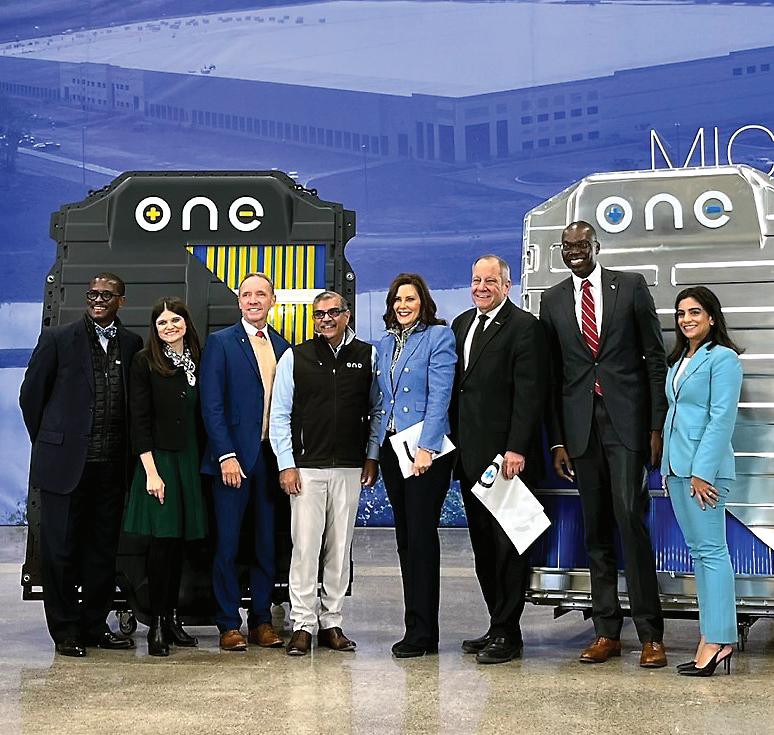
abundant, sustainable materials.
There are 10 assembly plants in the Detroit Region producing 1.8 million vehicles annually, with six EV and hybrid vehicle models currently produced and five new EV models to be assembled in the region by 2027. Building on this advanced manufacturing prowess are additional investments like Magna’s three Michigan expansion projects totaling $526 million and Dunamis Charge’s opening of an EV charger manufacturing facility.
In addition to the fresh crop of electrification projects, the Detroit Region is a hotspot for novel autonomous mobility technologies like the world’s first autonomous wheel. Norwegian company wheel.me opened its first U.S. location in the Detroit Region to produce its autonomous wheel, which can be mounted to any object and convert existing infrastructure into autonomous robots.
Whether it’s manufacturing batteries for electric vehicles or developing autonomous mobility technology, the reason companies like ONE, Magna, Dunamis, and wheel.me chose to establish or expand their footprint in the Detroit Region is the unparalleled access to mobility assets. From the 80,000 annual engineering graduates to the 29 OEM headquarters and tech
centers, there’s no mobility ecosystem in the world like the Detroit Region.
The Detroit Region’s mobility assets will be strengthened by a $52.2 million U.S. Economic Development Administration award to the Global Epicenter of Mobility (GEM) initiative. Whether it’s verifying site readiness for new manufacturing facilities, building up talent and workforce pipelines, or helping existing manufacturers transition to electric, GEM ensures that the road to future mobility continues to go through the Detroit Region.
The Detroit Region was built upon entrepreneurial grit and innovative spirit. Whether it was Henry Ford transforming the assembly line in 1913 or ONE CEO Mujeeb Ijaz revolutionizing electric vehicle battery technology in 2022, ingenuity in the mobility sector is a part of the Detroit Region’s DNA. As key investments continue to land in the Detroit Region and the GEM initiative ramps up, the Detroit Region is proving to once again be the Global Epicenter of Mobility.
Learn more about the mobility revolution in the Detroit Region: detroitregionalpartnership.com

Continued from page 35
for those fleets that employ the sophisticated drive-cycle data tracking technologies. Telematics data can shed light on routes, travel times, and parking locations.
PwC has similar advice to closely examine fleet economics to gain a good understanding of total cost of ownership, in order to compare with the TCO of EVs. That requires a good understanding of the EV rollout plans of original equipment manufacturers, especially as more options emerge for medium- and heavy-duty trucks.

Considering the Available Incentives
“When building out an electric vehicle transition plan, commercial fleets should really take a holistic approach to identifying priority locations,” Forni advises. “Companies will want to consider the incentives that are available to them in each region [in which] they operate.”
Incentives are available at the federal level, often joined by state and utility incentives. “Some states and utilities have particularly substantial funding available for the purchase or lease of electric vehicles and their infrastructure, and therefore could be considered more ideal locations to pilot an electric fleet, if financial savings are a priority,” she says. “Determine the extent of utility fleet electrification support offered in each territory, and of course assess the vehicle segments operated and their use cases at each location.”
Blake notes that the federal government invited states to submit plans to support vehicle electrification in order to tap into federal funding. “Most of them have been reviewed and approved. Every state has something, but it’s a mat-
ter of to what degree.”
A lot of states have turned the federal funding into grants or credits for purchasing EVs and charging infrastructure. His state of New Jersey has developed a variety of incentives, including sales tax exemptions, purchase rebates for vehicles and chargers, and deals for developers of multifamily housing that included charging infrastructure.
Power Availability
Then there’s the whole question of power availability. It’s no secret that key location factors vary significantly depending on the kind of project — the cost and availability of electricity have been a big deal for some projects, less so for others. Fleet electrification is likely to shuffle up the priorities going forward, according to Robinson.
He cites Duke Energy studies suggesting that a fleet of 50 large trucks or tractor-trailers will require about nine megawatts of peak demand power availability for charging — that’s about what the Empire State Building requires, he says. Now consider the fact that transportation and logistics operations tend to cluster, for geographic and infrastructure reasons. “Right now, in a lot of areas
where we have transportation, warehousing, and large distribution centers, they might be at points in the grid that don’t necessarily have capacity,” Robinson observes.
He points to a study from National Grid and Hitachi Energy8 that spotlights the challenges utilities can face as clusters of industrial and logistics operators start upping their demand for power by electrifying fleets. Long-term impacts could be substantial, the study found, with peak loads in some areas increasing by 60 percent.
For some companies pursuing electrification, “the timeline to meet goals might not line up with what is realistic in certain parts of the country,” Robinson says. “The issue is not generation, it’s distribution — where these companies are relative to available capacity. As they add additional megawatt demand onto their list of wants when it comes to optimal locations, that will begin to kind of change the contenders for transportation and warehousing.”
As they consider locations to venture into electrification, “fleets should also take into account the climate and terrain of each location,” Forni says. “I say this because companies might want to avoid initially launching electric vehicles in more dramatic environments where excessive heat or cold could reduce the electric range of the vehicle. In the same vein, some routes are easier to electrify than others due to the daily range required, whether the vehicle is able to return to a depot or employee’s home during operation, or how many stops a vehicle needs to make.”
SUPERIOR-SIZE YOUR SUPPLY CHAIN.






MICHIGAN
PURE OPPORTUNITY ®


Only Michigan has a supply chain that includes four Great Lakes with an extensive network of marine highways and 33 deep-water ports. It’s how the world’s top manufacturing, engineering and mobility businesses get the upper hand in global logistics. Seize your opportunity at MICHIGANBUSINESS.ORG
 LAKE SUPERIOR
LAKE SUPERIOR
Diversifying the Economy Puts Kansas in Driver’s Seat
As a new era of transportation in America charges up, Kansas’ vision is helping companies electrify the next generation of driving.
endeavors. And Kansas’ 10-year transportation plan includes significant funding for a new EV charging network in the state.
A New Incentives Toolkit
To win intense competition among several states for Panasonic, Kansas unveiled a new incentive toolkit designed to help attract $1 billion+ megaprojects. A thoughtful blend of tax and other financial incentives that was passed in record time with bipartisan support, the Attracting Powerful Economic Expansion (APEX) Act is a differencemaker in a time of challenging and evolving global competition for businesses and jobs.
The dramatic shift toward electric vehicles has created numerous opportunities to produce EV batteries, software solutions, charging stations and more.
In northeast Kansas, one of the nation’s largest EV battery manufacturing facilities of its kind is under construction. Panasonic recently chose De Soto for a $4 billion plant to produce a new generation, highcapacity EV battery. The plant will employ at least 4,000 workers and create another 4,000 ancillary jobs, with an annual economic impact of $2.5 billion in the state — a once-in-a-generation opportunity to transform Kansas’ economy.
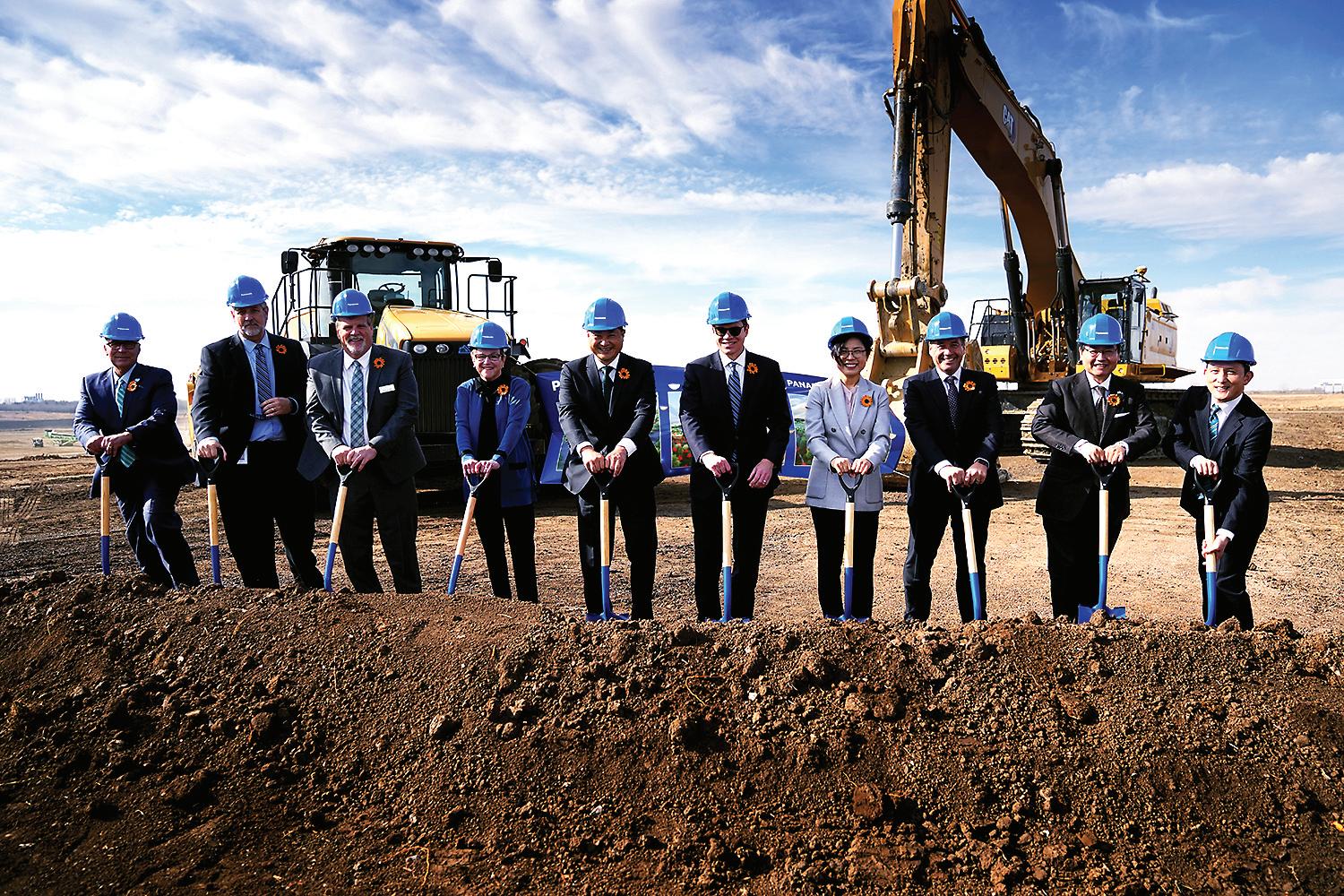
With the plan announced in July 2022, the Panasonic site now is bustling with construction activity. Mass production will begin by early 2025 to help meet North America’s fast-growing market for EVs.
“Innovations happening right here in Kansas will accelerate the future of electric vehicles on a global scale,” Governor Laura Kelly said. “We will be the production epicenter for batteries that will power the increasing demand for EVs and a more sustainable world.”
As projections show more than half of U.S. car sales will be electric by 2030, Kansas is becoming the nation’s leader in manufacturing EV batteries and other EV-related
APEX gives Kansas an edge over other states in addressing the unique needs of companies planning megaprojects. Panasonic was the first. APEX was employed a second time this February with Integra Technologies —– a Wichita semiconductor manufacturer. Pending its application for federal CHIPS Act funding, Integra will invest $1.8 billion building a new, one-million-square-foot plant — creating 2,000 direct and 3,000 indirect jobs.
Kansas continues recruiting other opportunities to transform the statewide economy. For example, Orange EV recently announced the relocation of its headquarters to a much larger facility in Kansas City, Kansas. The move will enable the company to double the number of electric terminal trucks, also known as yard trucks or mules, produced annually to meet surging demand.
Building the Skilled Workforce
There’s also heightened focus in Kansas on fortifying the skilled manufacturing labor pool in a state already known for robust workforce development and talent attraction. The state’s new Office of Registered Apprenticeship in the Department of Commerce is preparing more Kansans for the modern workforce, with thousands of participants currently gaining the skills necessary to succeed in industries driving the state’s future. Workforce strategies include working closely with higher education institutions to match degrees with business needs and keep more graduates in the state.
Meanwhile, the Office of Innovation continues recruiting cuttingedge businesses that make Kansas the innovation hub of the Midwest and one of the best places in the country and world to do business. The state’s recent record-setting business growth is proof. Since 2019, Kansas has attracted $15.2 billion in new capital investment and created and retained over 54,000 jobs — all made possible by supercharged, visionary efforts to modernize economic development and seize more opportunities now and in the future.
To learn more about doing business in Kansas, please visit kansascommerce.gov.
This article was paid for and written by the Kansas Department of Commerce and approved by Area Development.


EXPANDING THE EV BATTERY PIPELINE
 BY KAREN THUERMER
BY KAREN THUERMER
The auto and battery industries are investing billions of dollars to upgrade and build factories to meet increasing demand for electric vehicles (EVs). But they face a shortage of rare earth materials that go into making these batteries. This is causing the price of EVs to skyrocket.
Fortunately, the materials are highly recyclable. Benchmark Mineral Intelligence says that such scrap will account for about 78 percent of recyclable materials globally in 2025 and remain the main source for recyclers until the mid-2030s, when used batteries take over.1
CleanTechnica reports that by 2050, battery recycling could supply 22–27 percent of lithium, 40–46 percent of nickel, and 45–52 percent of cobalt needed for electric vehicles in the U.S. It further states that currently the United States only has about 7 percent of the global recycling capacity while China has 80 percent.2
Consequently, the race is on to collect and recycle used lithium-ion batteries, despite projections that it could take a decade or more before ample used lithium-ion batteries become available.3
In fact, in early 2019, the Argonne National Laboratory announced the launch of ReCell, the U.S. Department of Energy’s (DOE) Vehicle Technologies Office’s (VTO) first advanced battery recycling R&D center. The goal is to help enable the U.S. to compete in a global recycling industry and also reduce its reliance on foreign sources of battery materials.4
The “Battery Belt”
Several companies are jumping into the market and making major investments. Among them are Li-Cycle and Redwood Materials, which is building a new battery materials and recycling facility on a 600-acres near Charleston, S.C.5 South Carolina is regarded as part of the “Battery Belt” corridor that extends from Michigan to Georgia.
Redwood operates a similar campus in northern Nevada where it recovers more than 95 percent of the rare metals from batteries in Volkswagen and Audi EVs per a partnership announced in July with Volkswagen Group of America. Redwood’s $3.5 billion Charleston investment will eventually employ 1,500 people and produce 100 GWh of cathode and anode components per year — enough components to supply more than one million EVs. The facility should be operational by the end of next year.
Spoke & Hub Technologies™
Li-Cycle proprietary Spoke & Hub Technologies™ use a combination of safe mechanical size reduction and
hydrometallurgical resource recovery specifically designed for lithium-ion battery recycling. Li-Cycle is developing its first commercial regional Hub facility in Rochester, N.Y., which is expected to be commissioned in 2023 and operate as a hydrometallurgical refinery facility. The Hub is designed to process approximately 90,000 tonnes of lithium-ion battery input annually or battery materials that are equivalent to 225,000 EVs per year. Once completed, it will be one of the world’s largest facilities and sources of recycled lithium.6
The Hub facility complements Li-Cycle’s Rochester Spoke facility, completed in December 2020. Its first Spoke facility opened in early 2020 in Kingston, Ontario. In addition, the company opened two other lithium battery recycling facilities in 2022 in Tuscaloosa, Ala., and Gilbert, Ariz. Alabama was chosen to support needs in the Southeast; Arizona due to its proximity to California.
The company is also expanding into Europe with planned Spokes in Germany and Norway. By the end of 2023, the company expects to have a total of 65,000 tonnes per year of lithium-ion battery material processing capacity across its Spoke network in North America and Europe.
1 https://chargedevs.com/newswire/benchmark-mineralsbattery-production-scrap-will-be-the-main-source-ofrecyclable-material-this-decade/
2 https://cleantechnica.com/2022/12/24/ev-batteryrecycling-jumping-in/
3 https://www.nytimes.com/2022/12/21/business/energyenvironment/battery-recycling-electric-vehicles.html
4 https://www.anl.gov/article/doe-launches-its-first-lithiumion-battery-recycling-rd-center-recell
5 https://www.areadevelopment.com/newsItems/12-16-2022/redwood-materials-camp-hall-commerce-park-ridgeville-south-carolina.shtml
6 https://pv-magazine-usacom/2021/12/14/li-cycle-to-upsize-rochester-hub-facility-in-face-of-growing-demand/
Industry is at a Crossroads. It’s
called Woodstock, Ontario, Canada
The City of Woodstock is a rapidly growing, industry based community, centrally located in Southwestern Ontario’s manufacturing corridor. Uniquely positioned at the crossroads of super-highways 401 and 403, Woodstock boasts one of the most optimal ground transportation systems in the province. Quick and easy access to international airports, shipping ports and rail systems, further add to Woodstock’s logistical excellence.

With these attributes Woodstock has attracted more than $2 billion in new investment and created more than 4500 private sector jobs over the last decade. At the intersections of industry, productivity and sustainability, it’s not surprising why economic powerhouses such as Toyota, Sysco & General Motors continue to invest in the City of Woodstock.
(519) 539 2382 x2115
information @ cityofwoodstock.ca
www. cometothecrossroads .com
TOP-FOUR LOCATION CONSIDERATIONS FOR EV BATTERY PLANTS
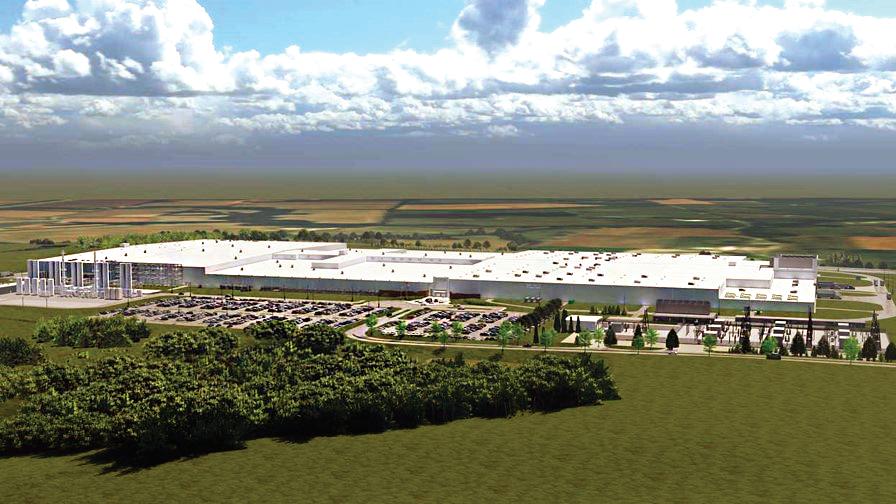 BY
BY
As the world’s top automotive manufacturers continue to ramp up their investments in electric vehicles, they’ve come to realize that one of their largest obstacles is supplying the batteries needed for these new EVs. Finding the optimum site for an EV battery manufacturing plant doesn’t just involve securing a location that meets square footage requirements alone — a daunting task in and of itself, given a facility of this magnitude generally needs millions of square feet to operate. The site selection process for battery plant operations typically involves any number of complicated factors, and this critical decision often needs to be made swiftly.
When looking for the perfect location for EV battery manufacturing operations, it’s important to understand the search necessitates an efficient and methodical evaluation process. Our Industrial team has been down this path numerous times, and the following represent the top-four site selection considerations we have learned to keep top of mind.
Consideration No. 1: Prioritize Your Needs
• Related operations — An important piece of the site location puzzle is determining how your plant is going to function in relation to other operations. Obviously, these batteries will go into electric vehicles. So, where is the car manufacturing facility located in proximity to the prospective site? Where will the raw materials needed to manufacture the batteries come from? How will you transport between facilities?
• Workforce needs — The production of EV batteries will require a specialized labor force that fits the needs of
the location as well as your facility.
• Local or state incentives — To attract companies, local economic boards and state governments often offer incentives that weigh heavily in terms of deciding where you should base your operation. It’s important to be aware, however, that the overall cost of a property of this scale can be so great that even the most enticing of tax incentives may not make it worth your while.
• Size of the investment — How big is the facility in terms of square footage and acreage? Also, what is a realistic project budget?
• Future growth — This can be somewhat of a guessing game for manufacturers, but it pays to have a plan for future growth up front. When do you anticipate needing to expand and how big will that expansion be? How will you plan for future manufacturing technologies, some of which have yet to be fully understood?
• Assign priorities to a wish list — You’re going to have a veritable
laundry list of “must-haves” and should assign a factor of importance to each of those items since you’re most likely going to be comparing multiple sites and compromising on some of your wishes. Determine what’s most important to the stakeholders and establish a logical way to evaluate each of the different options.
Consideration No. 2: Highlight Unique Constraints
• Utility demands versus available capacity — Not every region can effectively handle the enormous utility demands of EV battery plants. Even if a site can potentially provide capacity or availability of utilities, it may require massive upgrades or utility line extensions that yield a high cost or involve a protracted schedule. It’s important to know up front how much time and money those additional projects will cost for each potential site.
• Access — Transportation infrastructure is critical. What modes of transportation will you use to bring in raw materials and ship out finished products? Where is your workforce coming from? How much of the infrastructure needed already exists and how much do you need to build?
• Environmental concerns — An early assessment of environmental risks is critical. This may include weather and climate threats such as flooding and tornadoes; it can also involve site constraints of existing natural resources like wetlands and streams that require special permitting. Weather can affect how and when you work. Consider the potential impact to the construction project and the long-term resilience of the facility.
• Entitlements and permitting — Even when the local community is welcoming your project and the jobs it brings with open arms, you still must play by the rules. Each jurisdiction is different and will have its own unique process of project approvals to turn an expansive piece of agricultural land into the site for a state-of-the-art manufacturing facility. Because this process can have a big impact on the project cost and timeline, create a detailed plan for the required approvals during the site selection process. There may be site-specific permitting requirements, community engagement, negotiations, tradeoffs, and multiple levels of government involvement.
• Land acquisition — Allow adequate time for the land purchasing process. Are multiple landowners involved? What if you need more property or easements than you first anticipated?
• Costs of improvements — Construction cost has always been important, but cost escalation over the last few years has made budgets much harder to manage, with the COVID-19 pandemic and subsequent supply chain shortages playing heavily into that. Although challenging, having a clear picture of unique site construction considerations and overall project costs is critical. You should aim to identify special equipment needs, long lead materials, and local impacts to availabilities and costs. Having a contractor engaged in the early stages can pay huge dividends.
Consideration No. 3: Lay It Out
• Conceptualize site plans — This may be obvious, but you need to see a proposed layout of the site on paper. A picture is truly worth a
thousand words, and nothing gets a team and stakeholders talking better than a good visual. Depending on the audience, you may need to consider renderings to better illustrate the project. This may be your most valuable piece of information to guide decisions — so do not skimp on it.
• Not all acreage is created equal — The shape of the property, presence of naturally occurring features, and relation to surrounding infrastructure can all drastically change the appeal of a property for your specific project. Some constraints may be obvious, like a stream running through the middle of the site, or less obvious, like endangered species or sinkholes. Take the time to study each property carefully and identify where site constraints lie within the context of the overall project before you make a site selection.
• Engage the major disciplines — The success of your project will come from a wide range of technical experts bringing their abilities together for a common goal. Although it can be tempting to make assumptions based on previous projects when you are in the site selection stage, it is wise to solicit input from across the team early, so you do not start the project overlooking crucial scopes of work. Consider contracting with a builder for preliminary services and insight in the initial concept planning.
• Plan for the unknown — Things change. A major part of the site selection process is aimed at identifying unknowns, but a big project like this is bound to surprise you more than a few times. You may have a carefully considered building plan (that’s great!) and a considerate long-term growth strategy (even better!), but much of this plan will likely be upended in the natural evolution of a complicated construction proj-
ect. You can plan for this by making conservative assumptions, identifying backup options, and not getting trapped in the mindset of what you think you already know.
Consideration
No. 4: Establish a Project Strategy — Early
• Set the stage — Site selection is one of the first project stages that brings together many separate parties for a common goal. Seize this opportunity to establish practices that will facilitate the site selection and serve as the foundation for the rest of the project to build upon.
• Organize team communication — As mentioned, soliciting input from design consultants and contractors at the early stages of the site selection process has its benefits. The more people involved in the project, the more important it is to have an organized framework of communication and documentation. Establish communication channels so everyone is working at their optimum.
• Speed is everything! — It seems everyone is working on an expedited timeline to manufacture the batteries that power in-demand electric vehicles. So, an aggressive schedule often trumps cost. Understand the importance of timely information and allocate the necessary resources.
• Early releases — Consider the risk/ reward of early release design packages and early ordering of long lead procurement items — some of which may be affected by escalating costs or availability in a particular region. You may need to shift focus to accelerate the schedule.
• Track critical items — You have identified unique site constraints and potential roadblocks in your site evaluations. Some of these issues will be easily resolved, some will persist for many months, and some may become urgent problems. You must establish a system to track, assign priority, and elevate these crucial items. This must also include a clear understanding of the decision-making process and who has the authority to
make decisions. Too many teams fail to properly track and organize important issues effectively. This list will start during or before the site selection and will continue throughout the entire project.
A Vital Foundation
Setting out to establish an EV battery manufacturing facility is a highly complex, multilayered endeavor replete with numerous entities and countless individuals supporting its completion. What you do during the site selection process — which involves critical decisions that set the stage for every subsequent phase of the project — can ultimately make or break the success of your operation. As outlined in these top-four site selection considerations, setting processes, making key decisions, and getting the right people involved from the get-go creates a vital foundation that will support you through the entire life cycle of your project — and beyond. n
Finding Help
Know that there’s help out there. The Corporate Electric Vehicle Alliance that Forni represents is all about promoting the electrification of fleets and building the business case for producing a broader array of vehicle types. State and local economic development officials will have insights into regional incentives. And, adds Robinson from Duke Energy, “Companies should contact their utility representatives early on in the process to understand how the utility can support electric fleet adoption
over an extended period of time in any given location.”
“A fleet of EVs is not a slam-dunk for everybody,” Blake observes. Countless changes in processes will be needed, lots of employee training, and significant thought into charging infrastructure. “A lot of thought and planning needs to go into this before making the decision,” he explains.
That said, the potential cost benefits can be very attractive. And, Blake adds, “If it’s just breaking even but doing the right thing for
the environment, that’s the altruistic angle.” n
1 https://www.ceres.org/climate/transportation/ corporate-electric-vehicle-alliance
2 https://advocacy.consumerreports.org/press_release/ new-consumer-reports-analysis-shows-rising-gas-pricesramp-up-savings-for-ev-owners/
3 https://www.pwc.com/us/en/industrial-products/publications/assets/pwc-us-fleets-want-to-go-electric.pdf
4 https://www.businessinsider.com/amazon-creating-fleetof-electric-delivery-vehicles-rivian-2020-2
5 https://evmagazine.com/top10/top-10-companiesdriving-commercial-fleet-electrification
6 https://electrek.co/2022/11/02/largest-electric-schoolbus-fleet-providing-grid-demand-response/
7 https://smart.columbus.gov/playbook-assets/electricvehicle-fleet-adoption/ev-fleet-transition--what-toconsider
8 https://www.nationalgridus.com/media/pdfs/microsites/ ev-fleet-program/understandinggridimpactsofelectricfleets.pdf
From zero to scale in record time.
Arizona provides the premier platform for advanced mobility innovation in industries such as electric and automated vehicles. With a dynamic network of trailblazing companies and a top two rank for largest manufacturing job growth, there are endless possibilities to grow and scale. Businesses benefit from pro-innovation policies, proximity to three of the world’s largest economies, a robust supply chain and reliable energy. Plus, Arizona offers a lifestyle that allows employees to achieve their personal goals with breathtaking outdoor activities, vibrant arts and culture, easy commutes and an unmatched quality of life. It’s this perfect balance that makes life better here—and provides the winning combination for global innovators.






Strategies to Overcome Intensifying Industrial Real Estate Challenges

Companies facing constraints in the industrial real estate market should build extra time into their site searches and widen their geographic areas of search.
By Jacob Everett, CEcD, Founder, Corsa StrategiesIndustrial vacancy rates in the U.S. fell to historic lows during 2022 and finished the year at a crippling 3.0 percent1 — half the normal range of 6–7 percent. Las Vegas exemplifies this challenge with a vacancy rate of 1.5 percent. Detroit (1.8 percent) and Boston (2.6 percent) provide additional acute examples of this current dynamic. Toronto’s massive industrial market (the fourth-largest market in North America) spent 2022 below 1.0 percent.
The forces that pushed vacancy rates lower during 2022 were positive. Consumers were spending money, and the private sector was investing heavily; these are generally signs of a healthy economy. To an extent, low vacancy rates are a good thing, as empty buildings do no one any good. But just like unemployment, ultra-low rates become an impediment to economic growth.
Each turn of the calendar brings with it the excitement of new opportunities and adventures. While 2023 is no different, this new year also presents a healthy dose of uncertainty.
In 2022, we saw significant growth and investment across sectors. Expansion took place in the face of — and often despite — two defining limitations in the market: labor and industrial real estate availability. Unfortunately, trends indicate a challenging future for the industrial real estate environment.
Low Vacancy Rates: A Mixed Bag
Constraints
How will industrial vacancy rates impact our future? First, let’s consider recent history. The years 2010 through 2019 represent an incredible, sustained period of economic growth supported by ample industrial vacancy rates that ranged from 5 percent to 10 percent. Despite strong demand aggressively consuming space during this time, speculative industrial development — which in recent years has
accounted for more than two thirds of all industrial construction — played a critical role. Speculative developments provided enough industrial real estate to help the economy expand for a sustained period. Driven almost solely by this speculative activity, major markets added tens of millions of square feet to their industrial inventory each year during the latter part of this period. Without this availability, the economic successes of the 2010s would not have been possible.
While the topic is currently receiving limited attention, industrial vacancy rates will play a pivotal role in the economy’s ability to navigate the choppy waters ahead.
A Decline in Speculative Real Estate Projects

Speculative real estate development is driven by three items: anticipation of market demand, ability to finance, and predictable and enabling government policies.








The first and second items have taken a beating re -






cently. While current vacancy rates are low, future demand and rent levels are difficult to pinpoint, making investments in speculative industrial projects riskier than during the past decade. In addition, interest rates provide a two-pronged disincentive to speculative investment.
First, higher interest rates mean debt is more expensive. This puts pressure on every project’s pro forma and makes profitability more difficult, especially when facing uncertain rent levels. The second prong is guided by the basic economic principle of risk/reward. Prior to recent interest rate rises, investors were unable to generate gains by parking their dollars on the sidelines and were anxious to find investments that offered positive returns. Today, that dynamic is flipping on its head. Higher interest rates motivate investors to hold onto their dollars and benefit from the accruing interest rather than betting on higher-risk speculative development.
Due to these economic headwinds and higher interest rates, speculative industrial development is already retreating. For 2023, industrial construction starts are predicted to decline by 60 percent2 compared to 2022. The pipeline of in-process industrial speculative construction can’t solve this problem either; if all speculative projects became immediately available as vacant space (a purely theoretical scenario that is impossible in reality), the national vacancy rate would rise to 6.3 percent,3 barely into the healthy range. Historically low vacancy rates and an absence of robust industrial real estate development is a dangerous recipe for the U.S. economy.
Strategies for Overcoming Industrial Real Estate Challenges
Corporate leaders should consider the following approaches to achieve their growth objectives during this period of industrial real estate limitations:
• • Build extra room into timelines. Corporate location and expansion processes have moved at breakneck speed over the past few years. While this velocity is unlikely to wane, it is important for executives to force discussions about their industrial real estate needs to the forefront. Adding 90–180 days to the front end of traditional timelines will help companies avoid roadblocks and create more successful outcomes.
• • Cast a wider geographic net. As availability of modern industrial real estate continues to diminish, a preconceived location may not be viable. Even if a company finds a workable existing building, the lease/ purchase costs may be prohibitive. By building extra room into timelines, executives can expand their search areas. This work should take two forms:
First, investigate multiple regions of the country. While a certain area may be ideal, a few different regions across the country could be capable of achieving the company’s objectives. Evaluate and understand these different markets early in the process and maintain pathways to occupancy in at least two different regions until one of them is inked.
Second, consider secondary and tertiary locations. Tier 1 metros present a challenging combination of low industrial vacancy rates and the highest levels of demand. While there are many reasons to locate in a tier 1 area, it is not always necessary. The top 20 metros deservedly attract a lot of attention, but executives should challenge their teams to consider metros 21–50+, as there are lots of viable locations in that group for most operations.
Additionally, push the perimeters of the areas under consideration. Rather than constraining the search to 30 minutes from the airport or a key trans -
portation asset, consider 45 or 60 minutes. The outer reaches of a metro area often provide solid options for industrial operations. Bonus: some of these tertiary communities undertake speculative industrial development on their own. This means they may provide more cost-effective solutions as they are less inclined to follow the market in ratcheting up lease/ sale rates.
• • Have a plan B. In this case, B stands for build-to-suit. In the current economy, it is uncommon for companies to prefer a build-to-suit industrial real estate solution. Despite the preference for an existing building, a buildto-suit option should be prepared, especially if location is inflexible. Companies should use the extra few months added to the timeline to focus on this process. Having a build-to-suit plan with preliminary design, timelines, and cost estimates will help avoid a potential timing catastrophe if existing space cannot be procured. It is better to put the build-to-suit plan on the shelf if it proves unnecessary than to miss a mission-critical timeline.
• • Look for communities that prioritize partnerships. In the face of current market conditions, real estate developers are tempted to sit and wait. This makes public-private partnerships key to avoiding stagnation and spurring development. States, regions, and communities that choose to be aggressive and seek out engagement and investments with the real estate development community will separate themselves from the pack. Proactive regions that find ways to deliver speculative industrial space in 2024 and 2025 will find themselves in a position to attract growth while much of the country scrambles to recover from a period of development lethargy.
In Sum
In most markets, speculative industrial development is grinding to a halt and many regions will face a severe shortage of industrial real estate in the near future. Some predict this shortage will materialize as early as 2024. As discussed here, corporate leaders must adjust strategies to ensure their companies can continue growing.
Likewise, the public sector must proactively seek out partnership with real estate developers to deliver industrial space that can facilitate the expansion of existing businesses and the attraction of new companies. These actions by business leaders, real estate developers, and public officials will have a significant impact on how successfully and efficiently the economy is able to weather the current storm and continue growing. n
1 https://www.cbre.com/insights/figures/q4-2022-us-industrial-figures
2 https://prologis.getbynder.com/m/77de68d633c7a93f/original/SEVEN-SUPPLY-CHAINPREDICTIONS-FOR-2023.pdf
3 https://www.cushmanwakefield.com/en/united-states/insights/us-articles/whats-behindthe-sticker-shock-in-industrial
The Decentralization of U.S. Fintech Hubs
As the fintech sector continues to evolve, it’s primed to serve as a major economic catalyst in already established core, secondary, and emerging markets as well as new locations that offer the fundamentals for its growth.
 By Bobby Magnano, President, Financial Services, JLL; and Scott Redabaugh, Managing Director, Consulting, JLL
By Bobby Magnano, President, Financial Services, JLL; and Scott Redabaugh, Managing Director, Consulting, JLL
The current economic climate has rattled the tech industry. Layoffs and stock declines have reached fintech companies — firms that aim to develop a scalable financial services business via technology — after a multi-year growing spree.
However, these signs of the times are hardly a death knell for fintech. Many tech IPOs, including those of fintech unicorns, were wildly inflated by the 2021 venture capital (VC) bonanza. The plunges and layoffs making headlines today are corrections and reality checks after a period of explosive and unsustainable growth — not an indication that fintech is waning in prominence.
Instead, the fintech industry is continuing to push the boundaries of what is possible in the financial services industry. As the industry matures, fintech headquarters are no longer limited to traditional finance centers (i.e., New York City) and technology mega-hubs (i.e., the Bay Area). They are dispersing to cities where they can access the tech and finance talent that they need to build scale at salaries that don’t break the digital bank.
Fast Growth
The already expanding industry turbocharged when digital finance adoption increased en masse during the onset of COVID-19. People weren’t leaving home to visit bank tellers, and, in April 2020, digital banking adoption jumped 200 percent, according to Fidelity National Information Services.1
Many people also had time to kill on newfangled trading platforms. Digital
finance adoption remained elevated as consumer preferences shifted for the long haul and VC and traditional financial services companies poured billions into the sector.
Investment funding in fintech more than doubled in 2021 from pre-pandemic levels.2 That year, Coinbase went public with an $86 billion valuation, trailed by Nubank, Robinhood, and Toast, all unicorns valued at or above $20 billion.
While funding decreased through 2022 due to inflation, interest rates, the war in Ukraine, disruptions in the crypto industry, and other macroeconomic factors, it still ended the year above pre-pandemic levels.
America the Fintech-Savvy
The United States dominates the fintech market. U.S. deal funding represented 40 percent of all deals
globally, with Europe at a distant second with 27 percent of deal value. With 78 percent of U.S. con sumers now preferring to manage their finances online, fintech isn’t going anywhere anytime soon.3
The ability to access finance and tech talent is a key factor in the success of U.S. fintech companies, as well as traditional financial services firms that are racing to compete with their own fintech offerings. As a result, the fintech landscape has dispersed across a broader range of market types, including markets of moderate scale with lower business and living costs.
Several factors drive where U.S. fintech companies decide to set up their headquarters. The type of fintech solution (i.e., payments vs. banking) and, most importantly, workforce recruiting strategy are among them.

Broadly, the geography of the industry now falls into three categories: core hubs, an established second tier, and emerging growth markets.
Core Hubs: The Bay Area and New York City
New York and the Bay Area constitute core hubs. These are the most established and successful fintech epicenters in the world, home to a plethora of leading fintech companies that are supported by robust technology and financial infrastructure.
Fintech headquarters of note in these core hubs include Paypal, Robinhood, Intuit, Credit Karma, Mercury, FalconX, Square, Stripe, Plaid (Bay Area); and Lemonade, MoneyLion, Chainalysis, Ramp, Guava (NYC).
About half (45 percent) of the U.S. headquarters of fintech companies with more than 100 employees are located in these two metro areas alone.4 New York has a financial services industry and related occupation concentration at least two times higher than the U.S. average. The Bay Area has a technology occupation concentration at least twice the average. While growth is slower due to their already established nature, these markets secure a significant chunk of VC investment into fintech. At least 20 fintechs in New York City have reached unicorn status.
Core hubs cover virtually every fintech category among their ranks. That said, New York’s growing specialties include decentralized finance, with ConsenSys, Fireblocks, Gemini, NYDIG, and Paxos all headquartered in the area. New York is also a leader in democratizing access to financial services, with Guava, MoCaFi, Goalsetter, and Petal focused on financial equity.
As a historical financial center, home to Wall Street, New York has the infrastructure to provide an incubatory environment for fintech companies. Innovation Lab, an accelerator co-founded by the Partnership Fund for New
York City and Accenture, is one of
The Bay Area, too, covers the gamut of fintech subsectors, but its emerging specialties are artificial intelligence (AI), analytics, and banking. The popular digital bank for startups, Mercury Technologies, is headquartered in San Francisco.
When it comes to talent, there’s a one-two punch involved with core markets: The availability of high-quality talent is greater than anywhere else, but the cost and salaries are also higher than anywhere else.
Looking forward, these areas will continue to provide a fertile ecosystem for fintech start-ups and emerging and mature enterprises.
Established Second Tiers: Los Angeles, Chicago, Boston, and Philadelphia
The established second tier comprises moderate growth markets with populations greater than 4 million. They host 17 percent of all U.S. fintech headquarters.
Fintech headquarters of note in these second-tier locations include StartEngine, Scratch Financial, BlackLine, FloQast (Los Angeles); Avant, Enfusion, M1 Finance, Zero Hash (Chicago); Evertrue, Flywire, Toast (Boston); and Envestnet, cred.ai, Picwell, Benefix (Philadelphia).
These markets have strong concentrations of technology and financial services activity, with moderate to high rates of growth for tech occupations and a financial services industry concentration that is up to 50 percent more than the U.S. average. Many of these cities have active accelerator scenes and prominent universities that feed fintech talent. For example, Boston benefits from the “Brainpower Triangle” of Tufts, MIT, and Harvard.
Emerging Growth Markets: Atlanta, Charlotte, Denver, Dallas, Salt Lake City
Emerging growth markets, which include both large population centers and more moderately sized metros, see moderate to high growth rates for financial services and high to very high growth rates for technology occupations. Fintechs in these regions often see investment from local VCs and financial services companies. Home to startup communities and deep technology talent pools, these areas account for most of the cross-state job creation in fintech, which, since 2016, has been concentrated in the South and Southwest.
A large market, Atlanta has been a payments processing and embedded finance hub since before the dot com boom. Fintech headquarters of note in Atlanta include Kabbage, Momnt, CharityVest, Bluefin, and CoreCard. “Transaction Alley,” a string of businesses along Inter-
THE FINTECH INDUSTRY IS CONTINUING TO PUSH THE BOUNDARIES OF WHAT IS POSSIBLE IN THE FINANCIAL SERVICES INDUSTRY.
state 85, processes about 70 percent of payment transactions in the U.S.5 And, Atlanta has notable information technology (IT) talent depth. Georgia Tech, Georgia State, Atlanta University Center Consortium, and Kennesaw State University all nurture fintech talent.
In Charlotte, financial services industry jobs are more than two times higher than the national average and have grown at a rate of more than 30 percent over the last five years.6 Technical occupations increased by 67 percent over the same period. Fintech headquarters of note in Charlotte include LendingTree, AvidXchange, Paymentus, and Finzly.
In addition to being a banking hub, Charlotte is home to the fintech operations of major financial firms. This includes the fintech division of Bank of America, which is headquartered in Charlotte, as well as that of Wells Fargo and Ally.
With its high concentration of IT talent — bolstered by the University of Denver’s Fintech Boot Camp — Denver is an attractive market for fintech startups and companies opening satellite offices. Fintech headquarters of note there include Western Union, Techstars (Boulder), TIFIN (Boulder), and Maxwell Financial, a digital mortgage platform for lenders, which recently relocated its headquarters to Denver from San Francisco. The region is also home to the fintech operations of Charles Schwab.
Dallas’ fintech headquarters of note include Bestow, Deposits, Apex Fintech Solutions, and Gig Wage. The city is emerging as a fintech hub because of its growing tech talent base paired with low taxes and affordable housing. While it lacks the history of Atlanta, it is an emerging payments processing hub.
UT Dallas, which is among the universities that feed talent into the region, offers a graduate certificate in fintech as well as a master’s degree in Financial Technology and Analytics.
Salt Lake City has also seen high rates of growth in both the financial services and IT industries. It boasts a pro-business regulatory environment, as well as incentives and programs that support the growth of startups, making it an attractive location for fintech. Salt Lake City’s fintech headquarters of note include Atomic, Divvy, AvidXchange, and Lendio.
The core hubs, established second tiers, and emerging markets discussed in this article have seen considerable growth in fintech activity. As the sector continues to evolve, these cities — and, perhaps, new areas with similar fundamentals — are primed to capitalize on fintech’s potential as a major economic catalyst in the future. n
1 https://www.cnbc.com/2020/05/27/coronavirus-crisis-mobile-banking-surge-is-a-shift-likelyto-stick.html
2 https://www.cbinsights.com/reports/CB-Insights_Venture-Report-2022.pdf
3 https://www.forbes.com/advisor/banking/digital-banking-survey-2022/
4 https://www.crunchbase.com/hub/fintech-companies-more-than-100-employees
5 https://www.protocol.com/fintech/atlanta-fintech-hub
6 https://charlotteregion.com/blog/2021/02/25/research-data/industry-insights-financialservices-in-the-charlotte-region/
First Person: Michael Morris – Continued from page 14
What are some of the most promising new cyber defense tools in the works?
Morris: One new approach we see in the market is the use of proactive cyber defense platforms. These non-persistent agent deployments can enable adversary pursuit — or threat-hunting teams — to leverage cyber threat intelligence and automation to quickly find and mitigate non-signatured attacks. Using new platforms like this allows the defensive cyber team to proactively “flip the script” on the attacker by detecting and mitigating threats before they’ve been able to cause major disruptions.
How can companies do a better job of mitigating damage from “social engineering” fraudsters who trick employees?
Morris: Implementing employee awareness training programs, as well as periodically testing employees, can help mitigate damage from social engineering threats. Enabling reporting protocols also can help by asking employees to report any fraudulent activities (such as spear phishing via email), and then ensuring managers minimize any negative impact that could occur when employees self-report (in a timely manner) being scammed. Additionally, building authentication methods for access to critical business systems and enforcing strong password policies for employees can thwart these threats of deception.
Are we doing a better job identifying, stopping, and/or prosecuting cyber terrorists?
Morris: Unfortunately, adversaries are continuously refining their craft. But the good news is that security teams and products are doing a better job identifying those cyber threats.
THE ASSIGNMENT
To find out more about the current cyber threats companies are facing and their responses to such threats, Area Development’s staff writer, Lisa Bastian, interviewed Michael Morris, a managing director in Deloitte’s Cyber Detect & Respond practice.
ANNUAL
37TH CORPORATE SURVEY
by GERALDINE GAMBALE , EditorCompanies looking to grow are facing an historically tight labor market and rising costs, but their plans to invest may be buoyed by recent government legislation.
As the nation began to emerge from the COVID-19 pandemic in 2022, companies were still faced with a multitude of challenges. Supply chain bottlenecks and labor shortages persisted. And as the Federal Reserve attempted to rein in rising prices — with inflation peaking at 9.1 percent in June 2022 1 — the economy slowed down and worries surfaced about an impending recession.
By the end of last year, rate hikes had brought inflation down to 6.5 percent, still more than three times the Fed’s 2 percent target. Unemployment, which had peaked during the pandemic (13 percent in the second quarter of 2020), registered just 3.5 percent as of December 2022 — the lowest rate since 1969! — indicating an extremely tight labor market for companies looking to hire.2 However,
consumers — buoyed by plentiful jobs and slowly decreasing prices — continued to spend.3
So, what does this all mean for the company that’s looking to invest and grow at its current or new location? Area Developmen t polled its corporate executive readers at the end of 2022 to find out about their plans and priorities for the coming year. The charts that follow illustrate their responses. Also included is commentary about the corporate responses from highly regarded consultants to industry.
Respondents’ Profile and Top Concerns
Nearly half of those responding to our 37th Annual Corporate Survey are with manufacturing firms, and 53 percent are either the owner of their company or the chairman, CEO, president or part-
ANNUAL Five or more 23% Three 8% Two 16%
ner. Forty-three percent operate just one domestic facility, 16 percent have two, and nearly a quarter are running five or more domestic facilities. Just 26 percent of our respondents operate foreign facilities. Of those that do, however, nearly half operate five or more.
Nearly 40 percent of the corporate respondents employ fewer than 100 people; a third of the respondents employ between 100 and 499 individuals all told, and about a fifth employ 1,000 or more people across their operations. Considering the size of their companies based on employment numbers, it’s no surprise that only 32 percent utilize the services of consultants when making their location and expansion decisions.
Interestingly, nearly 50 percent of the respondents to our Corporate Survey say recent government legislation, i.e., the CHIPS and Science Act, Inflation Reduction Act, etc., will greatly or moderately affect their expansion and investment plans. Nearly 60 percent say their plans will be greatly or moderately affected by current economic conditions, i.e., inflation, a potential recession, etc. In fact, nearly half say that economic pressures will exert the greatest influence on their plans, followed by 38
Number of facilities currently operating worldwide: Domestic: Four 9% Foreign (of the 26% who operate foreign facilities): One 13% Two 9% Three 17%
5 or more 48% 1,000 or more 21% 500-999 8% 100-499 33%
Four 13%
Number of people employed worldwide (all facilities): Fewer than 20 15% 20-49 8% 50-99 16%

Federal Legislation Affects Companies’ Investment Plans
The CHIPS Act and the ARPA are among government initiatives creating opportunities for some companies now and for others down the road.
Most executives prefer to focus on their business rather than Washington, D.C., but the survey suggests that major federal bills recently signed into law are spurring robust and rapid movement in the private sector. Half of the respondents report that recent legislation will “greatly” or “moderately” affect their companies’ expansion plans.
ANNUAL Extent to which recent government legislation (chips, inflation reduction, etc.) will affect your company’s expansion/investment plans: Greatly 21% Moderately 28%
Just drive around New Albany, Ohio, a northeastern suburb of Columbus, and you will see the visible impact of the 2022 CHIPS Act. Intel announced its plans for a $20 billion semiconductor manufacturing site in the area. Dirt is moving, roads are widening, and hammers are swinging. This is true on the Intel site and in all directions around it. CHIPS is driving real opportunity for companies and workers.
The Tulsa, Oklahoma, region is in the process of deploying more than $100 million in American Rescue Plan Act dollars. Much of this funding is being used on hard assets: aviation, ports, and wastewater systems. These investments will unlock more than 7,000 acres for development; nearly 60 percent of that land is targeted for industrial uses. ARPA is being used to accelerate the capacity for growth by decades.
The survey indicates that many companies are acutely aware of the opportunities these types of strategic investments create. While some businesses will benefit from the immediate expenditure of these dollars, countless more will benefit from the ability to expand through utilization of new infrastructure and real estate assets that will become available as a result of these projects.
• By Jacob Everett, CEcD, Founder, Corsa StrategiesNot at all 29% Slightly 29%
Not at all 11%
Extent to which current economic conditions (inflation, potential recession, etc.) will affect your company’s expansion/investment plans? Greatly 28% Moderately 31%
A Site To See
We simplify your search
Our program offers verified, vetted industrial sites in the Detroit region. Site selection is at the core of every successful venture.


Our industrial sites database helps you search with confidence, from anywhere in the world, and find a location where your business can grow in the 11-county Detroit region.
The Detroit Regional Partnership, your business expansion partner, works with expert engineers to evaluate, and verify vacant industrial sites. Our process ensures site data is precise and conmprehensive. Our team, meanwhile, provides wrap-around services such as talent recruitment and training, access to incentives, connections to government partners and permitting support.
verifiedindustrialproperties.com

NEARLY 50 PERCENT OF THE RESPONDENTS TO
SAY RECENT GOVERNMENT
percent who say workforce availability is their top concern.
Plans for New and/ or Expanded Facilities
Only 29 percent of the Corporate Survey respondents plan to open a new domestic facility in 2023. About a quarter of those new facilities will house manufacturing operations, with another quarter being warehouse/ distribution centers. More than half of the respondents say the new facilities will create fewer than 100 jobs all told, but 14 percent are planning to create 500–999 jobs and 10 percent 1,000 or more jobs in total at their new facilities. Additionally, 32 percent of the respondents say they plan on expanding the physical footprint of an existing domestic facility this year.
When it comes to the location of new domestic facilities, as in years past, the greatest percentage are planned for the southern regions of the U.S. The South, South Atlantic, and Southwest regions will account for 37 percent of the total planned new facilities. Another 15 percent are slated for the Mid -
SWEEPING TAX REFORMS HAVE DONE WONDERS FOR NORTH CAROLINA BUSINESSES.







LET THEM DO WONDERS FOR YOU.



At just 2.5% and falling, North Carolina’s corporate tax rate helps businesses across industries expand, invest, compete, attract talent and create jobs. Read the KPMG and Tax Foundation study.


































Corporate Decision-Makers Face a Challenging Environment
The rankings clearly reflect the impact of geopolitical and economic instability, as well as technology. The results of Area Development’s annual Corporate Survey reinforce the importance of key issues weighing on corporate decision-makers and site selection consultants. This year’s rankings also point to the increased importance of certain factors impacting location decisions for companies — factors that made a significant jump on this year’s list.
The high rankings associated with talent related issues such as labor costs and availability of skilled labor remain of top importance to corporate decision-makers, as they have for many years. This comes as no surprise given how important workforce is as a site selection factor.
In addition, it is important to note the items that took a big jump on the list from 2021 to 2022. A few noteworthy items include:
• Quality of life (closely aligned with attracting and retaining talent) jumping from being tied for 11th to 2nd place in the rankings;
• Construction costs moving up from being tied for 11th to 5th due to the impact of inflation;
• ICT/broadband leaping from 26th to 6th due to growth of remote working; and
• Energy costs, which did not appear as a separate entity on the list in 2021, ranking 8th among the site selection factors due to changes in energy policy and inflationary pressures.
As we look at the survey results for 2022 and consider what is ahead in 2023, we are facing significant headwinds and disruption at a level not seen for decades, if ever. The rankings clearly reflect the impact of legislation, fiscal policy, geopolitical and economic instability, and technology. These unchartered waters have created a more challenging environment for corporate decision-makers. Subsequent site selection decisions will be impacted in the short and long term based on what we are experiencing currently. Unlike in past economic downturns, we are unlikely to see the economic landscape bounce back to where it was before this current downturn.
•By Larry Gigerich, Executive Managing Director, Ginovuswest and 11 percent for the Middle Atlantic States.
It should be noted that a fifth of the respondents to our 37th Annual Corporate Survey say their new facilities include reshoring or near-shoring to Canada, Mexico, Puerto Rico or the U.S. In fact, 7 percent of the total planned new facilities are slated for Canada, 4 percent for Mexico, and 2 percent for Puerto Rico.

How Have Corporate Priorities Changed?
The factor ranked highest is labor costs, considered “very important” or “important” by 89.1 percent of the Corporate Survey respondents. This factor retained its first-place ranking from the previous year’s survey; however, in 2021, 96.4 percent of the respondents gave it a combined importance rating.




THE FACTOR RANKED HIGHEST IS LABOR COSTS, CONSIDERED “VERY IMPORTANT” OR “IMPORTANT” BY 89.1 PERCENT OF THE CORPORATE SURVEY RESPONDENTS.
Energy Costs Come to the Forefront
The shift away from carbon-emitting fuels and the unexpected spikes in natural gas pricing in 2022 have made industrial customers increasingly sensitive to energy costs in their location decisions.
One of 2022’s corporate site selection survey factors, energy costs, ranks high at #8, and the outlook for 2023 suggests that this issue will continue to be important as a deal-closing item for large industrial projects. Even as electric utilities continue to manage through historic supply chain constraints, incremental generation shifts away from carbon-emitting fuels, and the unexpected spikes in natural gas pricing in 2022, industrial customers are increasingly sensitive to energy costs in their location decisions. For many of these customers, annual electricity costs may outweigh any other business case line item — more than taxes, labor, logistics, or site costs — and even a $.01/kWh difference between two utilities may result in a multimillion-dollar difference annually between finalist locations.
In order to minimize risk, my clients are digging into the details of utility projections more than ever before, asking questions about rate structure, demand management, fuel costs and futures projections, fixed pricing options, taxes and fees, and long-term energy mix — in addition to energy availability, reliability, and availability of carbon-free or renewable sources. Utility pricing models, unique to each state and subject to often opaque regulation, make sorting through such comparisons a complex endeavor, and having a responsive and knowledgeable economic development utility team is critical to getting to a bottom line.
Utility partners have always been a critical part of the economic development team to attract new business to communities and states, but looking ahead, they will play an even bigger role in 2023 to win (or lose) large industrial site selection projects.
• By Lauren Berry, Manager, Location Analysis and Incentives, MAXIS AdvisorsQuality of life lands in the #2 spot in the rankings — a jump from a tie in 11th place the previous year — with a current 87.1 percent combined importance rating. As workers took stock of their lives during the pandemic, they placed greater emphasis on work/life balance, resigning from unfulfilling jobs or opting to continue working remotely or demanding greater flexibility in schedules. Quality of life thereby gained in importance among the site selection factors corporate executives consider


ANNUAL
37TH CORPORATE SURVEY
when planning their expansion or location moves, bumping availability of skilled labor into the #3 spot, considered “very important” or “important” by 85.8 percent of the Corporate Survey respondents. However, when considered in the “very important” rating alone, availability of skilled labor receives the highest rating of all the site selection factors at 54 percent.
In the previous year’s survey, energy availability and energy costs were rated together in third place with a combined importance rating of 94.7 percent.
Labor Related Factors Are Key
Companies are searching for the right balance of labor — at all skill levels — that can satisfy their needs not only now but also into the future.
The surge in industrial projects experienced over the last five to seven years has further stressed labor markets, so it’s not surprising to see the top three site selection factors related to labor force considerations. Additionally, we are surprised that the percentages are not higher on energy costs.
As the labor market tightens and new large projects are announcing 1,000+ plus job-creation goals, increasingly, automation and robotics are being considered to help supplement labor force concerns. Automation creates a “rob peter to pay paul” type of scenario, though. Where you are able to supplement automation, robotics, driverless technologies, etc. to complete the work of semi- to unskilled laborers, it creates an increased need for higher-skilled associates. In our opinion, that is where the current divide is in the workforce.
Hence the biggest critical location factor for labor now is where do we find the balance of unskilled, semiskilled, and higher-skilled workers to respond to the needs of industrial users today and in the future? Thus, the results of the survey surprised us, with technical schools and training programs ranking 17th and 21st, respectively. A state’s current labor force certainly matters when considering a location, but it’s becoming increasingly more important to consider efforts to create a future talent pipeline to sustain industrial operations over the long term. Further, automation also puts an emphasis on the need for energy availability and cost as most of these technologies need to be charged or be plugged in. While we were surprised that energy costs is not ranked higher, we understand that labor availability is a bigger concern.
The top concerns for most projects we are currently involved in are:
1. Are there any buildings/land sites available that can meet our utility usage; and
2. What does the labor environment look like?
The communities that demonstrate the availability of their resources — whether it’s labor, utilities, educational programs, incentives, etc. — in the near term, but also “sell” how their public-private partnership will ultimately mitigate the risks of the industrial user in the long-term, continue to win projects.
•By Bradley Migdal, Executive Managing Director; and Matt Niehoff, Senior Consulting Analyst; Cushman & WakefieldWe separated these factors in the current survey, and energy availability alone now ranks fourth, with an 82.3 percent combined importance rating. Oddly enough, with the rising costs of energy, the energy costs factor ends up in the #8 spot, considered “very important” or “important” by just 79.4 percent of the respondents.

However, construction costs, which was previously tied for 11th place last year, moves up to the #5 spot, again considered “very important” or “important” by more than 80 percent of the respondents. The scarcity of available land on which to construct new facilities is illustrated by the 10th place ranking of this factor, with a 78.1 percent combined importance

“WHEN IT COMES TO THE LOCATION OF NEW DOMESTIC FACILITIES, AS IN YEARS PAST, THE GREATEST PERCENTAGE ARE PLANNED FOR THE SOUTHERN REGIONS OF THE U.S.
Companies Are Recalibrating Their Priorities
In recent years many companies have been propelled to recalibrate priorities for their location strategies and resulting real estate footprints. The top site selection factors for occupiers today include the following:
• Availability of skilled labor — As demonstrated in this survey, skilled labor availability is still paramount, ranking #3 among the site selection factors. This factor is reinforced by CBRE’s U.S. Industrial & Logistics Occupier Survey 1 issued in October 2022, stating that 61 percent of respondents report that labor availability is a major impediment for the growth of their business. The fact that occupiers are improving conditions for workers and looking to increase automation means they are expecting leaner operations with more skilled labor.
• ICT/broadband — ICT/broadband is now a major site selection factor, jumping from #26 in 2021 to #6 in 2022. This is presumably a reflection of hybrid working, which has seen a huge increase in popularity recently. According to CBRE, by some measures a majority of Americans have the option of hybrid work, and over 70 percent of employees plan to expand their hybrid working options over the next three years. 2
• Energy costs — With energy costs ranked as #8, many businesses are seeking ways to offset ongoing operating expenses. Economic incentives are just one avenue companies can pursue to help alleviate these costs, especially during a period of rising inflation and changing market dynamics. In particular, many companies are poised to benefit from federal tax credits enacted as part of the 2022 Inflation Reduction Act (IRA), which allocated $369 billion for clean energy infrastructure to bring U.S. carbon emissions down 40 percent by 2030. Part of this transition will be facilitated with tax incentives to help investors reduce their utility costs in the coming years by investing in renewable energy infrastructure and improving energy storage.
• Construction costs — As demonstrated in this survey, construction costs are now a stronger site selection consideration, jumping from #19 in 2021 to #10 this year. The current period of elevated inflation presents particular challenges for the construction sector. While margins can vary significantly across projects in different sectors and locations, CBRE expects rising construction spending this year to support higher margins as contractors try to recoup higher input costs absorbed in 2022. Taken together, we expect total construction cost escalation in 2023 to be slightly higher than the historical norm but well below that of 2022. 3
1 https://www.cbre.com/insights/reports/2022-industrial-and-logistics-occupier-survey 2 https://www.cbre.com/insights/articles/the-hybrid-workplace-is-here-to-stay 3 https://www.cbre.com/insights/books/us-real-estate-market-outlook-2023/
• By Eric Stavriotis, Vice Chairman, CBRE Advisory & Transaction Servicesrating and up from 19th in the previous year’s Corporate Survey. And the need to get facilities up and running quickly is reflected in the increase in importance of expedited or “fast-track” permitting, jumping into the #16 spot in the rankings, up from its previous 22nd ranking, with a current combined importance rating of 70.3 percent.
Most amazing is the huge jump in the rating and ranking of ICT/broadband. More than 80 percent of the corporate respondents rate this factor as “very important” or “important,” landing it in the #6 spot this year, more than double the percentage giving it such a high rating in the previous year’s survey, when the respondents placed it only 26th among the factors. The continuation of the work-from-home trend over the last three years may be responsible for the large increase in importance of this factor.
Although corporate tax rate holds steady with a 7th place ranking, considered “very important” or “important” by 79.7 percent of the Corporate Survey respondents, the related factors of tax exemptions and state and local incentives are tied for the #13 spot, with a 73 percent combined importance rating.
Another surprising drop in the importance ratings and rankings goes to highway accessibility, which historically ranked high. Just 77.8 percent of the respondents to our 37th Annual Corporate Survey give this factor a combined importance rating, placing it in the #11 spot.

CORPORATE SURVEY *
The large decrease in importance of raw materials availability — dropping 26.5 percentage points and a 6th place ranking to the #22 spot this year with a combined importance rating of just 61.3 percent — is inexplicable. Over the past few years, COVID-related shutdowns and labor shortages, not to mention the war in Ukraine, have led to shortages of everything from paper and plastics to semiconductor chips, and these shortages are expected to last well into the future.
* All figures are percentages and are rounded to the nearest tenth of a percent.
Other factors landing in the bottom half of the rankings did not move significantly. However, interestingly, two factors recently added to our rankings — DEI and ESG initiatives — now are considered “very important” or “important” by more than 40 percent of the Corporate Survey respondents, although they rank only 28th and 29th, respectively, among the site selection factors. New workplace norms are promoting diversity, equity, and inclusion in the workplace, and DEI initiatives are now part


CORPORATE SURVEY COMBINED RATINGS
Site Selection Factors
* All figures are percentages and are the total of the “very important” and “important” ratings of the Area Development Corporate Survey and are rounded to the nearest tenth of a percent.
of the larger ESG corporate focus of reducing energy use/greenhouse gases and maintaining high standards of governance.
Looking Toward the Future
When the National Association of Manufacturers surveyed their members in the 4th quarter of 2022,4 more than 60 percent of the respondents expected a recession in 2023. However, as the economy added more than a half million jobs in January 2023,5 many analysts are rethinking their predictions of recession.
In order to weather whatever challenges lie ahead, according to Deloitte,6 the manufacturing sector will continue to invest in advanced technologies, implement a range of talent management strategies as well as tactics to enhance their supply chains, continue to progress toward smart factory transformations, and focus on corporate social responsibility. Companies that take such steps will be able to grow their operations and bottom lines over the course of 2023. •
1 https://tradingeconomics.com/united-states/inflation-cpi
2 https://www.reuters.com/world/us/us-job-growth-accelerates-januarywage-gains-moderate-2023-02-03/
3 https://www2.deloitte.com/us/en/insights/economy/consumer-pulse/ state-of-theus-consumer.html
4 https://www.nam.org/2022-fourth-quarter-manufacturers-outlook-survey/
5 https://www.cnn.com/2023/02/03/economy/january-jobs-report-final/ index.html
6 https://www2.deloitte.com/us/en/pages/energy-and-resources/articles/ manufacturing-industry-outlook.html
If you want to position your business in the most desirable area of the country right now, the Savannah corridor, take the easy route: use the Georgia Ports’ Site Selection Tool. This robust online resource allows you to easily compare land and building availability, work force readiness, plus, important utility and transportation options. Real-time data. Really fast. Go to GAPorts.com/SiteSelection and set your sights on success.
19THANNUAL
by GERALDINE GAMBALE , EditorConsultants responding to our survey say economic conditions are affecting their clients’ expansion/investment plans, with labor and energy availability and costs of prime concern.
As in years past, only about a third of those responding to our Corporate Survey say they use the services of outside consultants when searching for a new location or site. Therefore, we would expect the results of our Consultants Survey to different somewhat — although not in all respects — from the results of our Corporate Survey.
Profile of Responding Consultants
Nearly all of those responding to our 19th Annual Consultants Survey are working on projects in the manufacturing sector. Three quarters are
also working on distribution/warehouse projects and half with clients having a need for a headquarters facility.
When it comes to the industries the responding consultants are working with, more than 60 percent are helping those in the automotive/battery as well as consumer products sectors; nearly 60 percent work with food processing companies too; and around 40 percent with energy and life sciences/biotech firms. More than half the respondents say they work with very large firms in terms of employment, i.e., 5,000 or more employees, while more than 60 percent work with companies having anywhere from 100 to 4,999 workers.
Nearly three quarters of the respondents to our Consultants Survey say their clients who ask them to perform a location search have already narrowed down the geographic area in which they wish to locate, with two thirds gathering preliminary data. Meanwhile, half also say many of their clients have not actively initiated a site search when they engage their services.
Three quarters of the responding consultants say recent government legislation, i.e., the CHIPS and Science Act and Inflation Reduction Act, will greatly or moderately affect their clients’ expansion and investment plans. A similar percentage also say their clients’ investment and expansion plans will be greatly or moderately affected by current economic conditions, i.e., inflation, a potential recession, etc. These economic pressures are cited by more than half of the respondents as most affecting client plans, while a third cite workforce availability as having the most effect. The respondents to our Corporate Survey actually agree with the consultants on what is going to most affect their location/expansion plans.
19TH
What Are Their Clients’ Plans?
Another point on which the Consultants Survey respondents and Corporate Survey respondents agree is where domestic location and expansion projects will be located.
The respondents to our 19th Annual Consultants Survey say most of their clients’ projects are slated for the southern region of the U.S. — 16 percent of the projects for the South and the same percentage for the South Atlantic and 15 percent for the Southwest, with 13 percent of the total projects going to the Midwest.
The timeline for these new location or expansion projects is between six and 12 months, say 67 percent of the responding consultants, with 60 percent also saying some projects take a year to 18 months. More than a third of the respondents to the Consultants Survey say some projects take longer than 18 months. Interestingly, 80 percent of the responding consultants say they are currently working with international companies pursuing foreign direct investment into the United States.
Site Selection Priorities
Also, as in years past, the consultants give the site selection factors much higher importance rankings than did the Corporate Survey respondents. Whereas none of the corporate respondents give the factors a combined “very important” or “important” rating of more than 89.1 percent, the responding consultants give 11 of the 31 factors a combined importance rating of more than 90 percent.
Ranked #1 is availability of skilled labor, tied for #1 with energy availability, both factors receiving a combined importance rating of 98.3 percent. It seems like the tight labor market is top of mind for the con-
Lubbock, Texas Announces a Expansion Sw t
With more than 20 years experience creating authentic Mexican frozen treats, Tropicale Foods, the No. 1 Hispanic frozen novelty company in the U.S., announced its new location will be in Lubbock, Texas. This expansion brings with it 500 new jobs and $66.8 million of capital investment to West Texas.

For more tasty details on this announcement, scan the QR code below.

THREE QUARTERS OF THE RESPONDING CONSULTANTS SAY RECENT GOVERNMENT LEGISLATION WILL
Domestic location or expansion projects consultants are working on are slated for the following regions (as a percentage of total number of projects):
sultants, as is the global energy shortage exacerbated by the war in Ukraine.
The costs associated with these factors are right up there in the ratings and rankings. Labor costs ranks third (up from 13th in the previous year’s Consultants Survey), considered “very important” or “important” by 96.6 percent of the respondents to the 19th Annual Consultants Survey, up more than 10 percentage points in the ratings from the previous year’s survey. And, energy costs lands in the #6 spot with a combined importance rating of 96.5 percent.
TN) 16%
Plains (IA, KS, NE, ND, SD) 5%
Mountain (CO, ID, MT, NV, UT, WY) 6%
Southwest (AZ, NM, OK, TX)
Pacific (AK, CA, HI, OR, WA)
Rico
Respondents’ timeline for these new facilities and/or facility expansions is:
Less than 6 month
months
months
than 18 months
Are you currently working with any companies/foreigninternational direct investment into U.S.?
Tied for the #3 spot with labor costs are proximity to major markets, which was ranked #1 in the previous year’s Consultants Survey, and state and local incentives. As the consultants help companies navigate the incentives landscape and comply with incentives’ requirements, it’s no surprise this factor receives such a high ranking.
Related to proximity to major markets is highway accessibility and proximity to suppliers. These latter two factors both rank seventh as does available land; all three factors are considered “very important” or “important” by 94.9 percent of the responding consultants. With industrial vacancy rates reaching historic lows in 2022,1 it’s surprising that available buildings dropped six places to #16 in the rankings, although it still has a combined importance rating of 84.5 percent.
The last two site selection factors achieving a combined importance rating of more than 90 percent are expedited or “fast-track” permitting and construction costs. Those looking to establish new facilities are still feeling the effects of supply chain shortages drawing out timetables and inflating costs.
Although environmental regulations didn’t jump much in the rank-
GREATLY OR MODERATELY AFFECT THEIR CLIENTS’ EXPANSION AND INVESTMENT PLANS.







THE RESPONDENTS TO OUR CONSULTANTS SURVEY RANK AVAILABILITY OF SKILLED LABOR AND ENERGY AVAILABILITY AS THE MOST IMPORTANT LOCATION FACTORS.
CONSULTANTS SURVEY COMBINED RATINGS *
Site Selection Factors
ings (it’s in a tie for 14th place), its combined importance rating increased more than 10 percentage points to 87.7 percent. In fact, 50 percent of those responding to our 19th Annual Consultants Survey rate environmental, social, and governance or ESG initiatives as “very important” or “important.”
Given the importance of developing a pipeline of skilled labor, it’s not surprising that technical schools and training programs are both considered “very important” or “important” by more than 80 percent of the respondents to our Consultants Survey.
What is surprising is the difference in the rating and ranking of quality of life between the Corporate and Consultants surveys. Whereas the Corporate Survey respondents rank this factor second, with an 87.1 percent combined importance rating, only 72.4 of the responding consultants give it a similar rating and place quality of life in the #25 spot among the site selection factors. The respondents to our Consultants Survey feel that quality of life is subordinate to operational factors.
* All figures are percentages and are the total of the “very important” and “important” ratings of the Area Development Consultants Survey and are rounded to the nearest tenth of a percent.
* * 2021 ranking
Just as the ICT/broadband factor jumped
vedp.org
Being near the nation’s capital, we have the ability to bring people from all over the globe into our headquarters. Having access to that diverse talent is absolutely critical for our success.
 NAZZIC KEENE
NAZZIC KEENE
CONSULTANTS SURVEY *
more than 40 percentage points in its combined importance rating in the Corporate Survey, it had a large increase in its combined importance rating in the 19th Annual Consultants Survey — more than 30 percentage points, though it still ranked only in 23rd place among the factors. The continuation of the remote work trend is reflected in the increased importance of this factor.
The respondents’ comments on the ratings and rankings of the site selection factors by their corporate counterparts are included within the 37th Annual Corporate Survey and provide further insight on what they feel companies’ priorities should be. •
1 https://www.statista.com/statistics/194081/us-industrialvacancy-rate-forecasts-from-2010/
ALABAMA
Greg Canfield, Secretary Alabama Department of Commerce
401 Adams Ave. P.O. Box 304106 Montgomery, AL 36130-4106
800-248-0033 contact@madeinalabama.com www.madeinalabama.com
ARIZONA
Sandra Watson, President & CEO Arizona Commerce Authority
100 N. 7th Ave., Suite 400 Phoenix, AZ 85007 602-845-1200 Azcommerce.com
Karla Moran, Principal, Economic Development Salt River Project
P.O. Box 52025 Phoenix, AZ 85072-2025 602-236-2396 Mobile: 480-748-9291 Karla.Moran@srpnet.com PowerToGrowPHX.com
ARKANSAS
Clark Cogbill, Director of Marketing Arkansas Economic Development Commission
1 Commerce Way, Ste. 601 Little Rock, AR 72202 501-682-5996 ccogbill@arkansasedc.com arkansasedc.com
CONNECTICUT
John Bourdeaux, President, Head of Business Development AdvanceCT
470 James St., Suite 9 New Haven, CT 06513 860-571-6206 jbourdeaux@advancect.org www.AdvanceCT.org
FLORIDA
Cathy Chambers, Director of Economic Development Florida Power & Light 700 Universe Blvd. CEA/JB Juno Beach, FL 33408 904-349-0589
Cathy.Chambers@fpl.com https://www.poweringflorida.com/
FL/GA/LA/SC/NC
Rosemary Fagler, Economic Development Manager Weyerhauser
13005 S.W. 1st Road, Suite 241 Newberry, FL 32669 352-415-4518
rose.fagler@weyerhaeuser.com www.weyerhaeuser.com
SPONSORS
GEORGIA
Stacy Watson, Director of Economic & Industrial Development
Georgia Ports Authority
P.O. Box 2406 Savanah, GA 31402 912-964-3879
swatson@gaports.com www.gaports.com
Charlie Moseley, Economic Development Manager
Georgia Power
75 5th St. NW Atlanta, GA 30308 www.selectgeorgia.com
ILLINOIS
Paulina San Millan, Vice President, Business Development Intersect Illinois
230 W. Monroe St., Suite 330 Chicago IL 60606 312-667-6010 www.intersectillinois.org
KENTUCKY
Kristina Slattery, Commissioner, Business Development Kentucky Cabinet for Economic Development Old Capitol Annex 300 West Broadway Frankfort, KY 40601 502-564-7670
800-626-2930
https://ced.ky.gov/
LOUISIANA
Louisiana Economic Development 617 North 3rd Street Baton Rouge, LA 70802
225-342-3000
Toll Free: 800-450-8115
OpportunityLouisiana.com
MICHIGAN
Maureen Donohue Krauss, President & CEO Detroit Regional Partnership
1001 Woodward Ave., Suite 800 Detroit, Michigan 48226
www.detroitregionalpartnership.com
Tyler Rossmaessler, Executive Director
Flint & Genesee Economic Alliance
519 S. Saginaw St., Suite 200 Flint, MI 48502
810-600-1404
info@flintandgenesee.org
DevelopFlintandGenesee.org
Susan Proctor, Director, Strategic Initiatives, Growth and Development
Michigan Economic Development Corporation
300 N. Washington Sq. Lansing, MI 48913
517-719-0393
888-522-0103
proctors1@michigan.org
michiganbusiness.org/pure-opportunity
MISSISSIPPI
Laura Hipp, Deputy Executive Director
Mississippi Development Authority
501 N. West Street
Jackson, MS, 39201
P.O. Box 849
Jackson, MS 39205 601-359-3449 or 1-800-360-3323
lhipp@mississippi.org
https://mississippi.org/
NORTH CAROLINA
Economic Development Partnership of North Carolina
Wells Fargo Capitol Center 150 Fayetteville St. #1200 Raleigh, NC 27601 919-447-7777
https://edpnc.com/
Tara Martin, Marketing Manager
Rockingham County Economic Development 425 NC Hwy. 65 Reidsville, NC 27320 336-342-8138
tmartin@co.rockingham.nc.us
www.gorockinghamcountync.com
OHIO
Nick O’Bruba, Marketing Director JobsOhio
41 S High St. #1500 Columbus, OH 43215 330-207-9034 JobsOhio.com
TENNESSEE
Allen Borden, Deputy Commissioner, Business, Community and Rural Development Tennessee Department of Economic and Community Development Tennessee Tower, 27th Floor 312 Rosa L. Parks Ave. Nashville, TN 37243 615-741-1888
allen.borden@tn.gov
https://TNECD.com
TEXAS
David Rushing, Director of Business Recruitment Lubbock Economic Development Alliance 1500 Broadway, Suite 600 Lubbock, TX 79401 800-687-5330
David.Rushing@LubbockEDA.org www.LubbockEDA.org
VIRGINIA
Jason El Koubi, President and CEO Virginia Economic Development Partnership 901 East Cary Street Richmond, VA 23219 804-545-5600 info@vedp.org
www.vedp.org
WISCONSIN
Heather C. Smith, EDFP, CPM, Senior Director, Business & Investment Attraction
Global Trade & Investment Wisconsin Economic Development Corp. 608-210-6740
Mobile: 608-234-7290
https://inwisconsin.com/
The Top Investment Location Prospects for Aerospace Manufacturing
Which are the most promising states and countries for aerospace production in a rapidly evolving sector-wide landscape?
By Scott Thompson, Global Aerospace & Defense Leader, PwCThe two essential stories of the aerospace and defense (A&D) industry in 2021–22 are an increasing pace of the recovery from pandemic demand shock across the commercial sector and the dawn of a new era of growth in defense spending.
Even more than 2021, 2022 was a year of partial recovery for civil aviation manufacturers after the 2020 pandemic-driven plunge that interrupted a decade of seemingly inexorable growth. Still, a full return to preCOVID-19 output levels appears to be some way off. Stubborn supply chain challenges and labor shortages1 continue to hinder many leading OEMs as they strive to fulfill a slew of new orders from carriers seeking to expand, rejuvenate, and/or green their fleets.
Meanwhile, the trajectory of the global defense industry for perhaps a decade to come is likely to be unprecedented growth.2 Total global military spending in 2021
surpassed the $2 trillion mark for the first time,3 rising to USD $2.113 trillion. Driven by geopolitical conflicts, an era of sustained, elevated demand in military aerospace production appears to have arrived.
For the ninth year in a row, PwC’s 2022 Aerospace Manufacturing Attractiveness Rankings report4 analyzes the key states and countries leading the A&D industry. We select metrics and data with an eye to helping companies find the optimal places to invest, build, expand, consolidate, or relocate their operations. The report can be a helpful tool in planning for production, enhancing the resiliency and transparency of manufacturing supply chains, and rebalancing cost structures.
Top 10 State Rankings for Aerospace Attractiveness

We continue to refine our rankings methodology, in part by increasing the number of metrics included. Our 2022 state and country rankings are based on 41 and 38 metrics, respectively. As the accompanying charts indicate, these are distributed across the same categories for both states and countries, except that geopolitical risk is excluded from the state rankings, being essentially identical for all states.
Overall, this year’s rankings reveal impressive resilience in the U.S. domestic A&D industry (including space) in the face of both expected and unexpected market changes. This picture contrasts with a rap-
idly evolving investment landscape across the global civil and military aviation manufacturing industries as they strive to respond to an economy drastically altered by war in Europe and ongoing pandemic-related challenges.
While aerospace manufacturing capacity can take years to build, our rankings suggest that leading A&D companies will be those that remain agile as the sector continues to rebound and grow. Many could emerge altered and even enhanced from the current phase of industry-wide transition.
State Rankings for Aerospace Manufacturing Attractiveness
This year’s state ratings emphasize the resilience of U.S. civil aviation manufacturing, despite the demand and supply-chain shocks of the COVID-19 era and the uncertainties of the recent inflationary period. The need for workforce development — growth, diversification, education and (re-) training — and the efforts under way to address that need also emerge strongly this year as themes in many states.
This year’s top-five states are all perennial leaders — all ranked in last year’s top 10, as all five have done since 2016. In fact, our top-10 lists for 2020 and 2021 include the same states in an only slightly reshuffled order, with two exceptions: Virginia notches up to 9th place from 11th in 2020, while last year’s 10th-place Kansas drops to 21st, with a plunge in its infrastructure metric from 2nd to 25th place (which the launch in mid-2022 of the Kansas Infrastructure Hub might soon restore).
Texas, never below the top four in our survey since its inception, holds its 2020 top spot this year, also coming in first, notably, for economy and tax policy. Georgia, which has placed in the top four in our ranking since 2015, lands in a strong 2nd. North Carolina, a top-10 finisher in our rankings in seven of the last eight years, reaches the number three spot, its best showing ever, with improvements in cost and infrastructure. Ohio, in our top nine since 2014 and our top three since 2016, slips slightly to 4th place, with a less robust showing for labor, economy, and tax policy. Indiana has cruised into a slot ranging from 5th to 8th place in each of the last seven years and regains 5th place, where the state last landed in 2017; a major factor is improvement in cost — up to 18th from 28th place last year.
Below the top five, it is worth pointing out that while the aerospace sector has boomed in Florida for years,
the state faces capacity challenges and stiff competition from other states. While Florida is well known for the diversity of its burgeoning A&D sector, recent public- and privatesector emphasis on workforce growth (as distinct from scale of investment or production) as a sector target is a promising development — and one that other states might emulate.
Considerations for your business: States with well-developed supply networks to the U.S. military, especially those that have invested in R&D capability enhancement in recent years, could expect strong growth in 2023 and beyond. Competition among top states to attract space-sector investment and green aviation startups reveals a growing emphasis on publicprivate collaborations and the development of new technologies that cross boundaries among the civil, defense, and space areas. And the urgent priority to decarbonize all aspects of flight ensures that, while it is hard to predict which technologies will take the lead, the pace of change is likely to accelerate.
Aerospace Manufacturing Attractiveness Rankings by Country
Our country rankings this year suggest a global aerospace industry in a state of flux — no surprise, given the complexity of doing business in the phase of latepandemic recovery. Across civil aviation, in both pax and cargo, patterns of traffic and leasing remain shifting and unsettled, which affects manufacturing demand.
Singapore, which has never ranked below third place in our survey, tops our list this year once more with a significant uptick in our metric for geopolitical risk (to 1st place from 12th) and despite dropping from 3rd to 14th place in cost.
In the U.S. in 2021, the A&D sector continued to support nearly two million jobs.5 The U.S. A&D market, second in our rankings this year, is expected to grow from $700.3 billion in 2021 to $755.24 billion by the end of 2022 (i.e., at a CAGR of 7.8 percent) and to reach $1047.07 billion in 2026 (CAGR of 8.5 percent).6 It is likely that A&D will recapture its status as the United States’ leading net exporter. The CHIPS Act, passed in 2022, constitutes a major effort to secure U.S. micro-
WHAT STATES AND COUNTRIES MIGHT A&D COMPANIES BEST CONSIDER AS THEY SEEK TO FULFILL THEIR LONG-TERM PRODUCTION STRATEGIES?
Top 10 Country Rankings for Aerospace Attractiveness

chip supply chains and is likely to have significant con sequences for U.S. A&D.
Canada holds its 2020 bronze medal this year, shoot ing up from 36th to 12th place for economy, while ranking number one in labor for the third year in a row. 2021 saw big news in military procurement as Canada announced the commitment of CDN $5 billion over six years to comprehensively modernize the badly ag ing systems of the North American Aerospace Defense Command (NORAD).7 Canada’s long-anticipated announcement of a new Indo-Pacific strategy to confront Chinese military and cyber threats will also likely lead to increased military spending.
The UK climbs from its 2021 10th spot to 4th this year, with improvement in our metrics for economy (from 13th to 4th) and cost (from 29th to 17th), owing in part to the pound’s recent weakness. In Brexit’s aftermath, the UK is actively encouraging foreign investment, and acute and persistent backlogs for British suppliers in Tier 2 A&D and below could widen prospects for new market entrants to increase capacity and simplify local supply chains.
Israel jumped to 5th place this year — its highest ranking ever, and up from 18th in 2021 — on the strength of significant growth in cost, labor, industry, and geopolitical risk. Israel’s defense-heavy A&D industry is the inverse of Canada’s civil-dominated sector. Last year saw a gigantic boost in Israeli weapons exports, which hit a record $11.3 billion in 2021 (a 33 percent increase over 2020),8 largely as a result of the Abraham Accords.
Farther down in our top 10, Ireland has landed 12th to 14th in our rankings in every year but one since 2014. This year’s impressive rise to 6th place reflects improvements in metrics for cost, labor, and geopolitical risk — reflecting Ireland’s relative political stability and
economic resilience (compared to many other European nations in current wartime conditions) and its favorable investment and trade climate (compared to uncertain-
This year’s survey results suggest that, while every sector of the global A&D industry is ever more globalized, securing the reliability, resiliency, and transparency of manufacturers’ supply networks has never been more critical. Strong collaborative relationships remain a key to success on a regional and global scale, as does support by investors of local training and education pipelines.
Context and a Caveat: Our Rankings’ Methodology
We believe that our report is a useful tool that companies can use as a framework to help them evaluate investment decisions and as a guide for strategic planning. Still, we emphasize that any methodology is imperfect. For example, there is no consistent data available for skilled manufacturing, a priority for the aerospace industry; however, we have been able to include metrics for ISO 9100 certifications in our state data since 2020. Note too that the data underlying our metrics dates from 2021, while our framing analysis incorporates new developments through early January 2022. And, of course, interpretations of our rankings should always be tailored to each company’s specific circumstances. n
1 https://www.jmc-groupltd.com/latest-news/shortage-of-skilled-aviation-engineersa-major-concern-post-pandemic-jmc-recruitment-solutions-survey-highlights/
2 https://www.thebusinessresearchcompany.com/press-release/global-defense-market-2021
3 https://www.sipri.org/media/press-release/2022/world-military-expenditure-passes2-trillion-first-time
4 https://www.pwc.com/us/en/industries/industrial-products/library/aerospacemanufacturing-attractiveness-rankings.html
5 https://facts.aia-aerospace.org/
6 https://www.reportlinker.com/p05376901/Aerospace-Defense-Global-Market-Briefing. html?utm_source=GNW
7 https://www.nytimes.com/2022/06/24/world/canada/canada-norad-air-defense.html
8 https://www.trade.gov/country-commercial-guides/israel-aerospace-and-defense
In August 2022, President Biden signed the $50+ billion CHIPS and Science Act (“CHIPS Act”) into law to encourage domestic investment in the semiconductor industry and alleviate dependency on foreign chip manufacturing. The semiconductor industry impacts almost all aspects of the U.S. economy and daily life — examples include automobiles, cell phones, and electronics vital to national security. To understand the significance of the new legislation, it is important to look at the history of the semiconductor industry in the U.S.
In the late 1980s and 1990s, semiconductor companies became early investors in offshoring their assembly and manufacturing plants to lower cost locations, mostly in eastern Asia. Land, taxes, and government regulations were among several reasons why offshoring became so cost-effective, along with the chips’ high value-to-weight ratio, making them easy to import back to the U.S. The U.S. simply could not compete with foreign government subsidies. As a result, only 10 percent of today’s world chip supply is produced in the U.S., despite being invented domestically.1
The CHIPS Act reinvigorates the United States’ semiconductor strategy and creates a federal landscape in which the industry can potentially afford to reinvest in the U.S. This is imperative to advance future projects and increase domestic production, as supply chain
THE CHIPS ACT
HOW IS THE CHIPS ACT DRIVING INVESTMENT IN THE U.S., AND HOW CAN LOCAL INITIATIVES HELP?
disruptions continue to plague U.S. OEMs and foreign manufacturing becomes more unreliable. As federal support continues to drive additional investment in the semiconductor industry, it is important for state and local governments to come to the table as well.

Dynamics between the federal, state, and local levels are of vital importance in leveraging federal investment. More specifically, it is paramount that state and local entities demonstrate a united front on their position as it relates to the CHIPS Act. For those locations seeking to attract the sector, state and local elected officials may do well to indicate a clear commitment to the semiconductor industry, first and foremost by noting their support of the CHIPS Act. This may be demonstrated through mechanisms
It is paramount that state and local entities demonstrate a united front on their position as it relates to the CHIPS Act.
such as writing a letter of support or showing a willingness to move at the speed of the industry.
Some additional examples of this commitment may include regular communications between officials and OEMs/suppliers, for example by assembling a semiconductor task force to advocate on their behalf at the federal level. Further, state and local governments may offer incentives, like a long-term tax credit or workforce investment program, or provide an ombudsman to assist current and new semiconductor companies with items such as talent identification and permitting. Finally, states and localities may invest in their educational systems by such means as creating relevant training programs, ultimately building an ecosystem around the industry.
The CHIPS Act has provided the U.S. with an exceptional opportunity for domestic investment through the semiconductor industry. Additionally, this legislation may serve as a gateway to increase investment and encourage even more domestic production in adjacent industries. Federal, state, and local initiatives will become more important than ever in advancing future projects as companies begin to draft and submit their CHIPS Act applications and the true impact of this legislation comes to fruition.
1 https://www.whitehouse.gov/briefing-room/statementsreleases/2022/08/09/fact-sheet-chips-and-science-actwill-lower-costs-create-jobs-strengthen-supply-chainsand-counter-china/


live we for
ribbon
cuttings
lasting partnerships prime locations ambitious vision expansive opportunity global teamwork growing together thoughtful investment
Wisconsin lives to help all sorts of companies find their version of success. That includes yours. From site selection through construction, opening and expansion, we provide support to ensure your vision becomes reality. After all, your success may inspire other companies to relocate or expand here, too. That’s how we look forward.

